Home Blog Presentation Ideas How To Do a Proper Thesis Defense Using the Right PowerPoint Presentation

How To Do a Proper Thesis Defense Using the Right PowerPoint Presentation
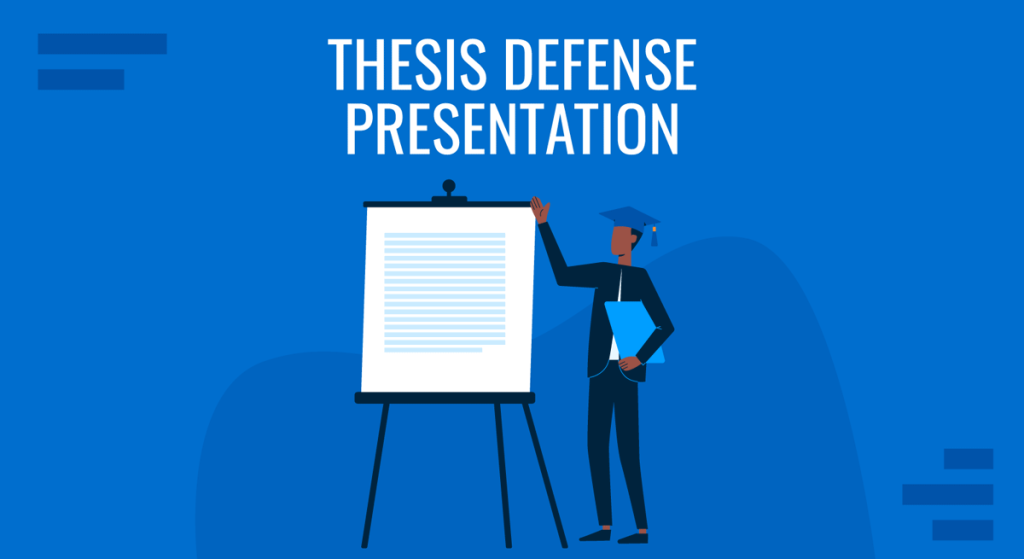
Writing a thesis is stressful, but preparing an oral defense can be even more painful. But it doesn’t have to be; with proper preparation and a good presentation, you will be able to better equip yourself comes time to present your thesis defense.
But what makes a good thesis defense?
A proper presentation helps you with your thesis defense because it helps you capture the panels’ attention and gives you cues and reminders on what to say as well.
It also helps keep your data organized while visually looking good and provides a flow structure for the rest of your presentation.
In today’s article, we will be giving you The Right PowerPoint Templates for Your Thesis Defense and a powerful outline composed of best practices and layouts specifically designed to help you defend your thesis in both written and oral presentations.
In the next segments of this article, we’ll walk you through the most feasible process on how to ace this kind of presentation.
Let’s dive into the outline of what makes a great thesis defense.
Thesis Defense Overview
Similarities.
- Type of Degree
Thesis and Dissertation Distinction Varies on Location
Three most common thesis defense myths, how to use chatgpt to structure your thesis.
- Introduction
- Literature Review
- Methodology
- Acknowledgements
- Questions and Answers
- Contact Information
- Tips During Your Oral Defense
- More Quick Tips on How to Present
A thesis defense is composed of two parts – a thesis and a defense.
The thesis, according to Grad School Hub , represents a student’s collective understanding of his or her program and major.
Universities often include a thesis in every course as one of the final requirements to earn a particular graduate or postgraduate degree.
The thesis, however, isn’t just a mere requirement.
It helps the students to grow out of their shell from their respective discipline and give them the opportunity to present all the findings of their study.
Moreover, some people think a thesis is just a long essay, but it’s not. Unlike an essay, a thesis needs to assert something.
This can be considered one of the most crucial research documents that a student makes during their academic schooling .
On the other hand, defense is the presentation of the pieces of evidence to support and prove your research.
It’s the most essential part of the thesis process.
Your presentation has to be prepared to answer questions from members of the committee and any other panel present, and it’s your job to convince them and defend your thesis with ample proof.
Prior to presenting, you have to carefully determine what appropriate evidence should be presented before the panel, depending on what thesis you have to defend.
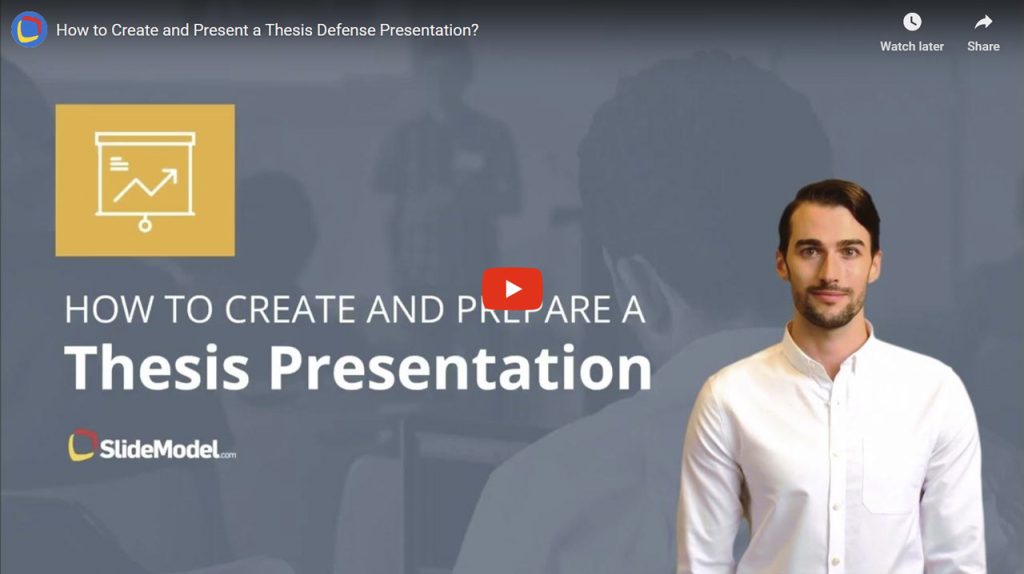
Thesis and Dissertation Distinguished
A thesis or dissertation is usually required to complete a particular graduate degree. These two words are often used interchangeably by most students when referring to research studies.
But while being almost similar in format or structure, it’s worth noting that they have significant differences that set them apart from each other.
The very reason why thesis and dissertation are treated the same is that these two are both extensive papers. Not just merely long essays like what others are claiming.
Both of these papers are extensive. This is why students are given ample time, usually the entire last semester of the last year of study, to complete all the requirements and finally acquire their degree.
With regards to structure, both papers are very similar with few differences.
Differences Between Thesis and Dissertation
One of the significant differences between the two is to whom the paper is assigned. A thesis is usually required for those students earning a bachelor’s or master’s degree. While a dissertation is for those, who want to obtain a doctorate degree.
However, not all students taking a master’s degree are required to make a thesis. Prior to their enrollment, they have been given a choice of whether they’ll go for a non-thesis program or with a thesis.
Those who have a plan to escalate their degree to a doctorate eventually should take the path of a thesis. This is to prepare themselves for a more extensive dissertation requirement as doctorate students. Otherwise, they will be only limited to earning a master’s degree.
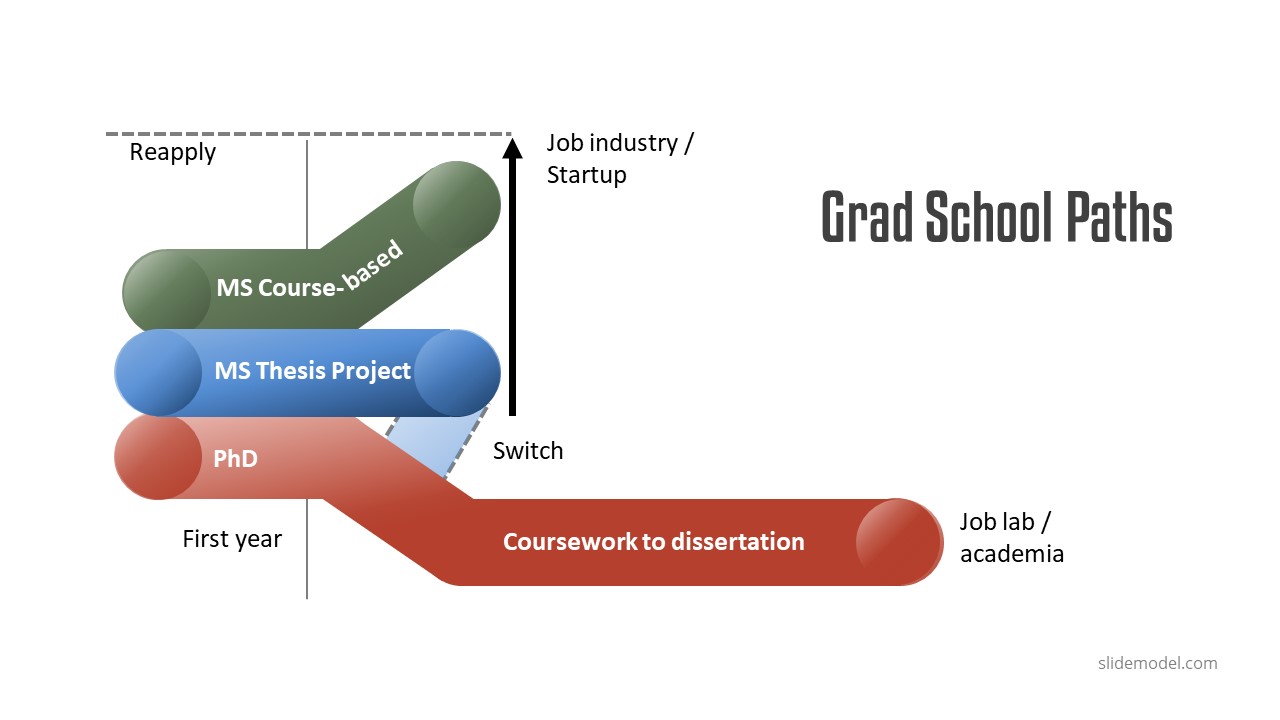
But above all, the most significant difference between the two papers is the purpose for which it is written.
A thesis, like what has been mentioned above, is being done by students obtaining a bachelor’s or master’s degree and has the purpose of testing their understanding of the discipline they’re engaged with.
A thesis is focused on obtaining technical expertise.
On the other hand, a dissertation is made for students to come up with an original study that other researchers haven’t already studied.
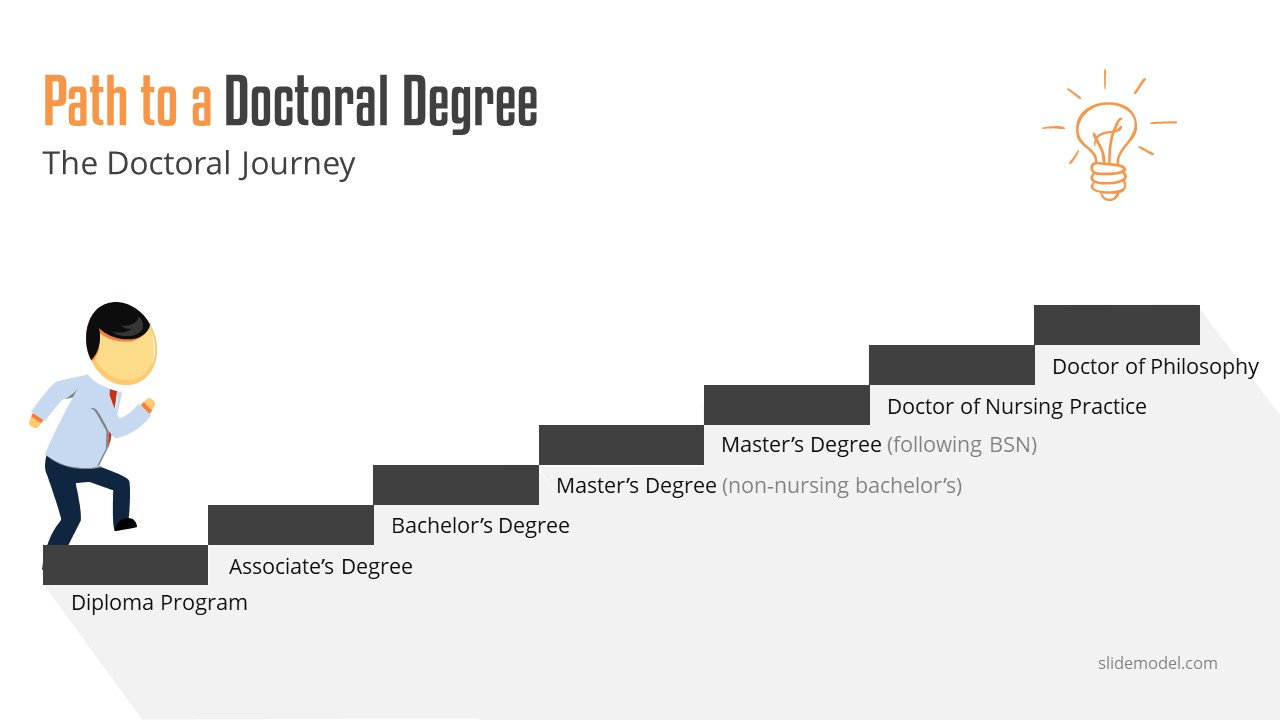
USA: In the United States of America, they consider a thesis shorter than a dissertation. In fact, aside from being a requirement to graduate in college, a thesis is now also inculcated in master’s degree programs. And since the dissertation is more extensive, the thesis is treated as preliminary in gaining a doctorate degree.
Europe: The distinction between the two papers is almost opposite to that of the USA. In Europe, a dissertation is only a broader research study from a post-graduate program and not the making of original research. Instead, educational systems in the said continent treat the doctoral thesis as a more elaborate paper writing.
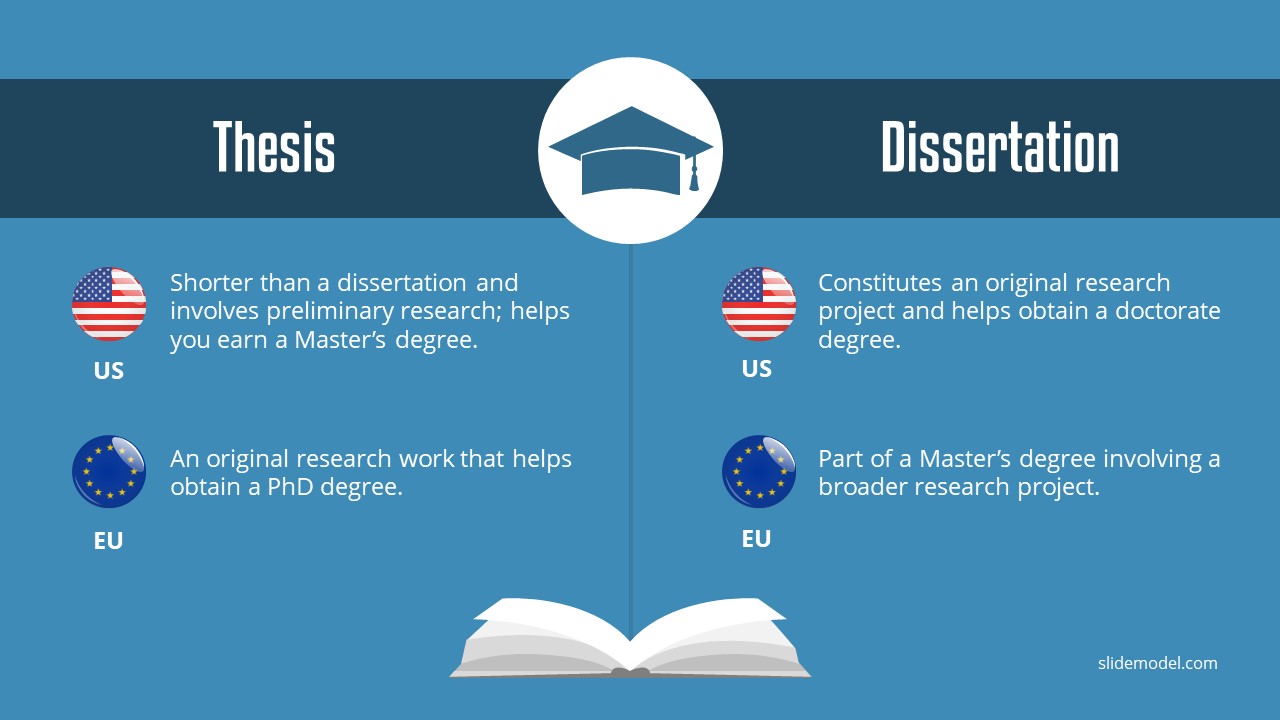
The difference between a thesis and a dissertation might not seem that big, but it’s important that we know what makes them different.
If your upcoming defense gives you pressure and uneasiness, it could be cause you are not sure what to expect. Today we will dispel three common thesis defense myths that will help you be more confident in your presentation.
“Answer all the questions correctly. Otherwise, your thesis won’t get approved.”
You are expected to have a focus on your research.
That being said, you have to study each part of your thesis, every detail, and even your sources.
You have to study and practice how to effectively deliver your presentation.
But don’t overthink to the extent that you’re stressing yourself to know everything perfectly.
Don’t overstress if you can’t answer one of the questions, this doesn’t necessarily mean the committee won’t approve your thesis.
You should know that research is a continuous study.
So you should expect that your committee will always be able to find a gap in your study to fill in future related research .
So in times you don’t exactly know the answer, admit it, and you’ll learn as they give their sides or suggestions.
Making up an answer will only displease your committee, so it’s to be upfront, honest, and transparent.
“The committee is just there to find holes in your study. They don’t care about you.”
One of the typical descriptions students have of the committee is that they are just there to poke holes in your thesis.
Going in with this perspective makes standing before them a nerve-wracking experience.
They’re not your enemy.
In fact, they are there to help you polish your study.
They might challenge you with difficult suggestions and tricky questions.
In the end, they will walk you through the process to come up with better results that won’t only benefit you but also your research.
They care about you and your study, and they’re ultimately there to make your thesis and the research better. Separate yourself from your work look at it objectively, and don’t take their comments personally .
“If your thesis defense isn’t successful, you have to start your thesis all over again”
An unsuccessful defense is one of the worst-case fears most students have.
One thing that you should be aware of is when you aren’t able to please your committee, you don’t need to start a new thesis again or go back to square one with your existing paper.
It’s unusual that your committee will ask you to change your topic and start from scratch again.
The fact that you’ve been permitted to defend your study means your research is almost complete.
They might suggest further details or ask you for minor revisions, and that’s normal.
But overall, you need to go into this defense thinking that your presentation will be successful. Otherwise, you are already setting yourself up for failure with the wrong mindset.
Remember that positive thoughts attract positive results.
Thesis Defense Presentation Structure and Slides Content
We can use language learning models like ChatGPT to help us curate the structure of our thesis presentation. Let’s see a step-by-step solution on how to apply this.
Step 1: Define the thesis topic and research questions
You can set the environment for ChatGPT to work by explaining what your thesis is going to cover and which specific questions you aim to address through the course of that document. This gives ChatGPT the context from which it shall formulate the structure. A prompt can be written like this:
“Take the role of an academic professional who shall help me to write my thesis. This thesis is going to cover the topic of (insert topic), and through its course, I want to answer these questions: Question 1 – Question 2 – Question 3 – Consider this information as the starting point for this chat.”
Step 2: Ask for an outline
With the previously provided information, ask ChatGPT to generate an outline for your presentation. If some of the points listed in the output don’t convince you, then chat with the interface until you reach a final outline. Then, ask to elaborate on each specific point for information or cues you may have overlooked.
Step 3: Ask ChatGPT which content should you place per slide
Instead of debating how are you going to trim your thesis into a presentation format, ask ChatGPT to do the decision process for you. You can be as specific as asking how many words per slide, how many slides should the presentation have, if you need any visual element, etc.
N.B.: We don’t recommend using ChatGPT to retrieve academic references as, in some cases, it can provide faulty results. You can ask if any facts on this presentation need to be checked or similar questions. ChatGPT is a powerful tool, but it shouldn’t be considered a bible, so be extra cautious about grabbing content directly from its outputs.
1. Title Page
This slide should contain the information that is provided on the title page of your hard copy . Here is an example of title page or cover slide for your title defense or thesis presentation.

- The title of your research paper
- Where you are studying
- Name and details of your course
- Name of Adviser
2. Introduction Slide
Your introduction slide should provide the committee with an idea of the following:
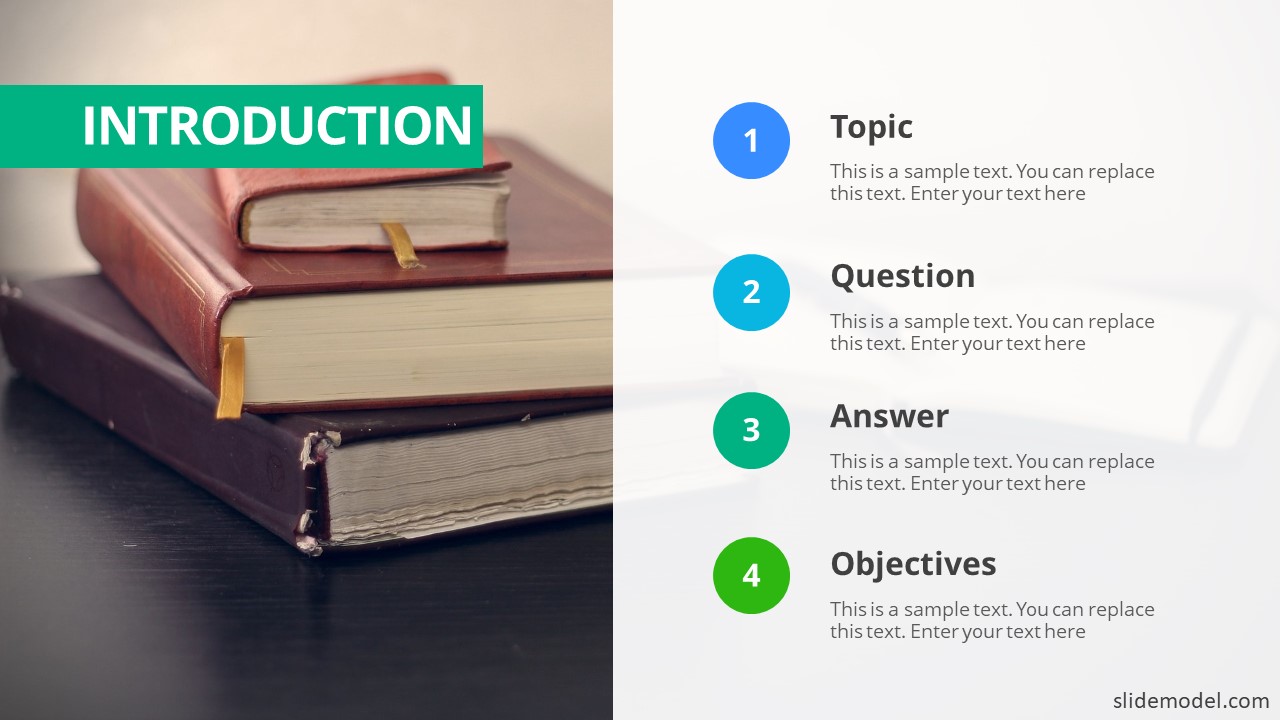
- What is the topic area that you are investigating ?
- What are the specific research questions that you set out to answer?
- Why is this question important to answer?
- What were the objectives of your research?
3. Literature Review Slide
It’s not necessary to cover everything that’s currently understood in the available literature. You may want to present the following content under a Literature Review slide:
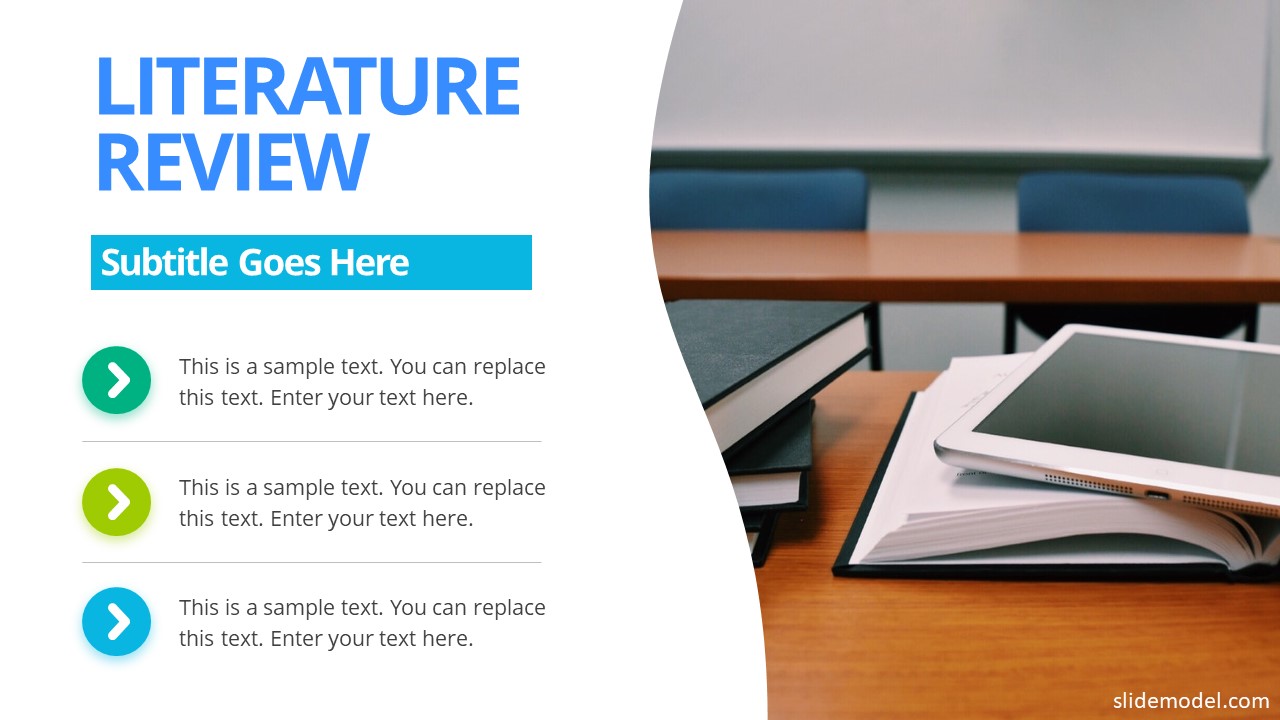
- Relevant current research that is close to your topic
- Different theories that may apply to your specific area of research
- Areas of weakness that are currently highlighted
4. Methodology Slide
Make sure to touch the factors below within your process, and include the following in the Methodology slide:
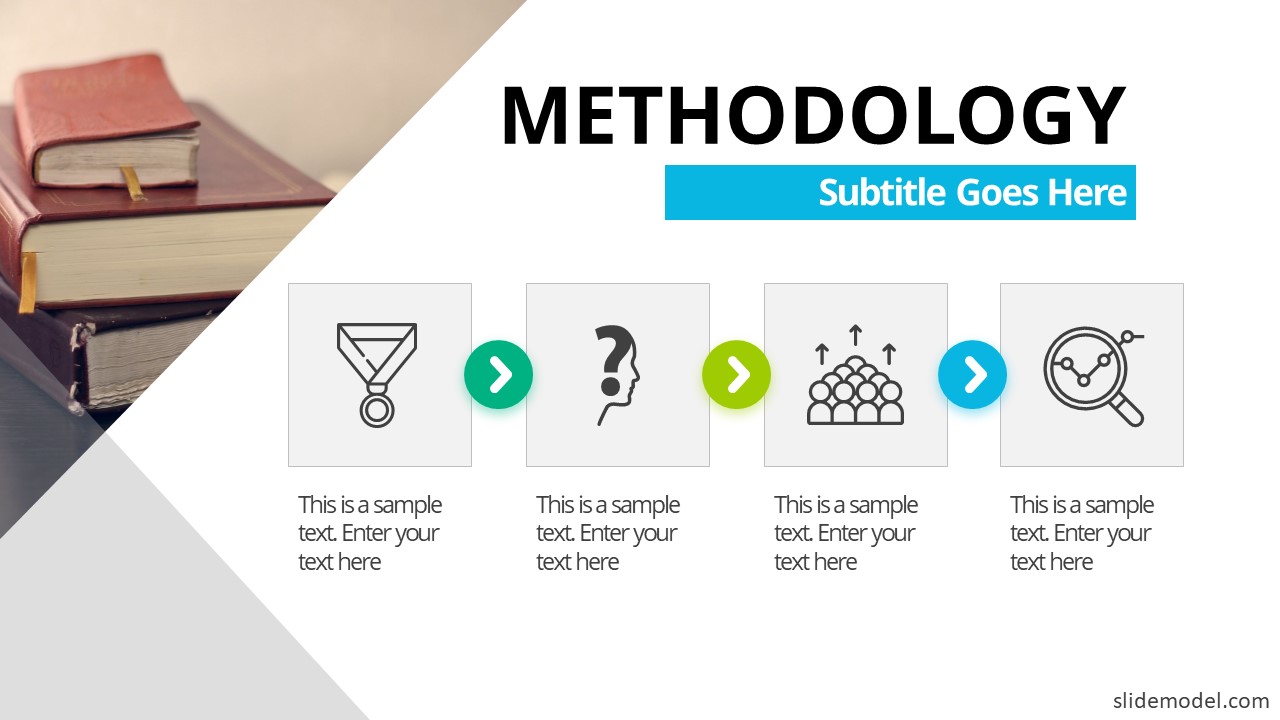
- The type of study you have conducted: qualitative, quantitative, or mixed
- The methods that you chose and why
- Details of the population, sampling methods, and other information
- Provide information regarding how you have analyzed the data that you have collected
5. Results Slide
This part should give the committee/audience a good understanding of what you’ve discovered during your research. The statistics & results slide could include the final results of your analysis, here is an example:

- An overall description of the data that you collected during your research
- The results of the analysis that you have done on that data
- What were the most significant findings from your data
6. Discussion Slide
Highlight here the meaning of the findings in relation to your discipline program and the research that you have done:
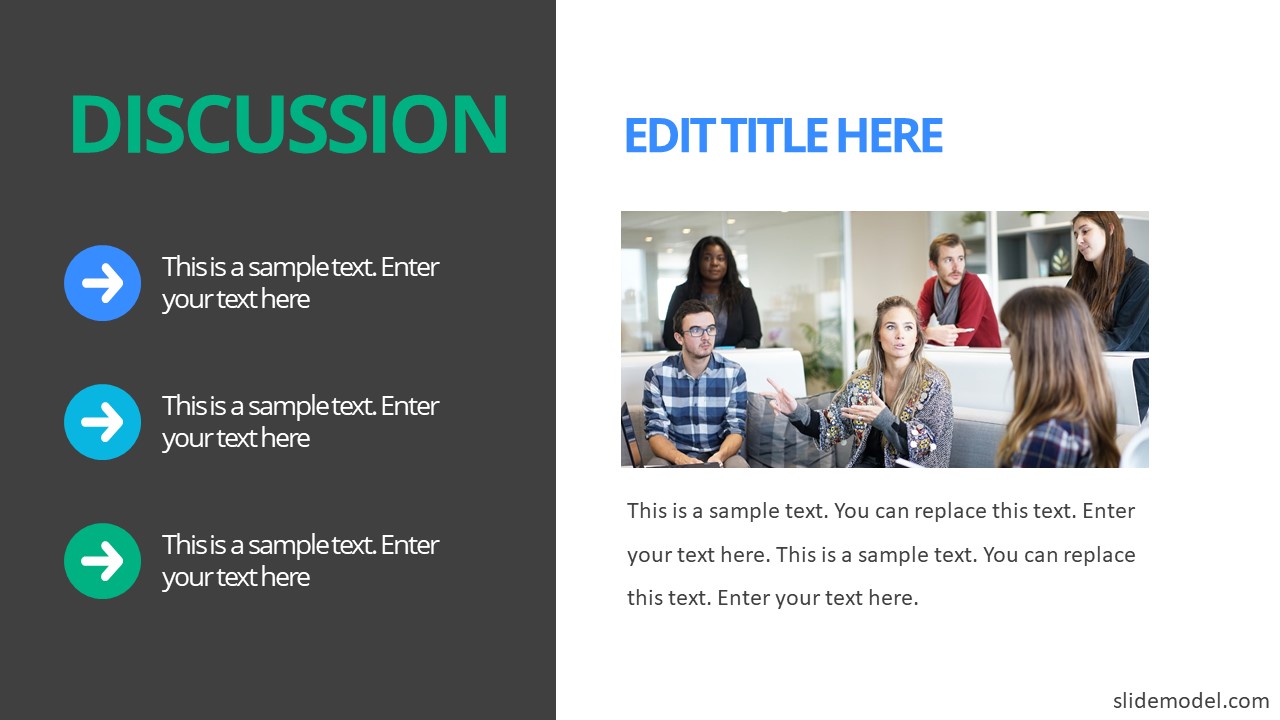
- What are the major findings, and what do they mean with regard to your research
- How do these findings relate to what others have found in the past
- How can you explain any unusual or surprising result
7. Conclusions Slide
You have to end your presentation with a conclusion summarizing all that you have found within your research. Here is an example of a Conclusion slide in a Thesis presentation:
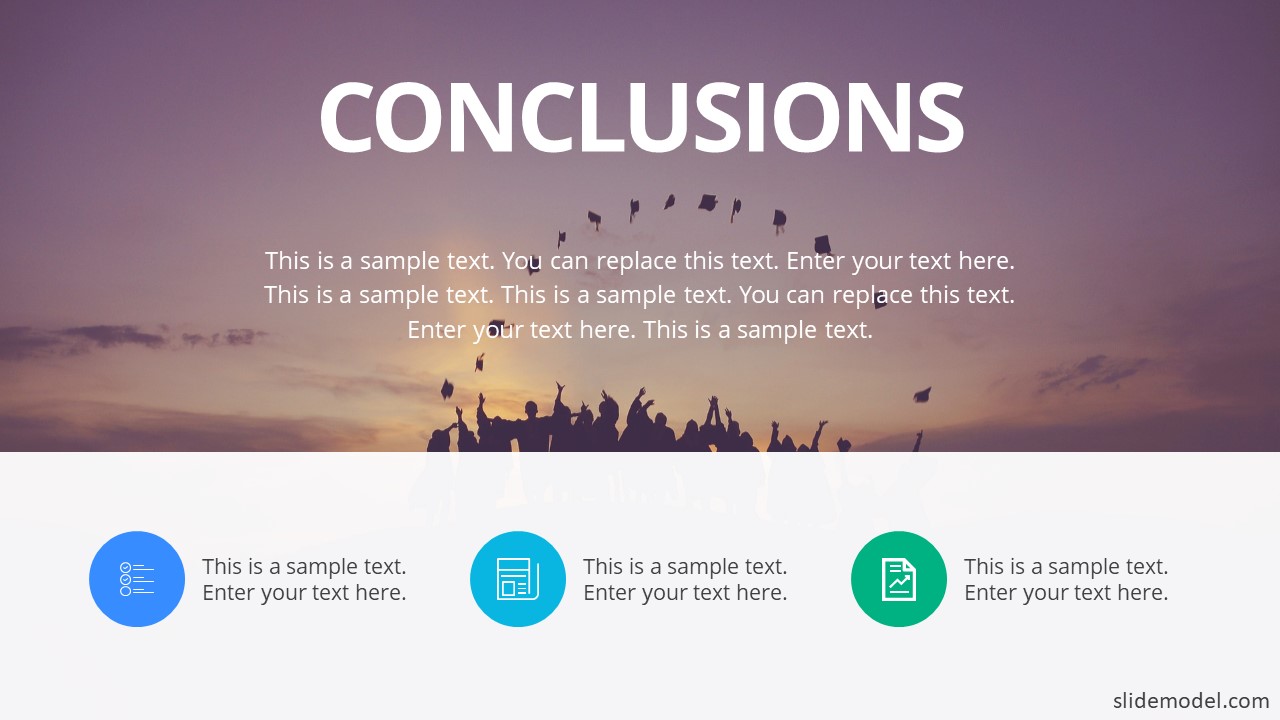
- Restate your research questions
- Show how your results answer these questions
- Show what contribution you have made
- State any limitations to the work you have done
- Suggest future research
- Make any recommendations
See Also: How to Create a Great Investors Pitch Deck and Close the Deal
8. Acknowledgements Slide
Express gratitude to your advisor, committee members, peers, and others who supported your research journey. This slide provides a moment to acknowledge the collaborative nature of academic work.
9. Questions and Answers Slide
Dedicate a slide for audience questions at the end of your presentation.
Encourage engagement by inviting questions from the audience.
Be prepared to provide clear and concise responses to inquiries.
10. References Slide
Include a slide listing your cited sources throughout your presentation.
Use a consistent citation style (APA, MLA, Chicago, etc.).
The References slide demonstrates your thorough engagement with existing literature.
11. Contact Information Slide
If you’re open to further inquiries or collaborations, consider adding your contact information.
Include your email address or relevant professional social media handles.
How to use SlideModel AI Presentation Maker for your Thesis Presentation
If you want to save hours of manual time, you can leverage AI tools to make your thesis presentation. The best part of integrating AI tools into our workflow is that we can pair them to get even better results than we expected. With SlideModel’s AI presentation maker , users can create an entire slide deck by introducing these variables:
- Topic of your thesis
- Number of slides to include in your thesis presentation
- Outline checkup
And that’s it! Download the AI-generated presentation in PPTX format or for Google Slides, and edit it if you require adding some extra content. The core elements are already done, and you can save countless hours of hard work.
Tips During Your Oral Defense!
Review your materials.
Even if you already feel confident with your upcoming presentation, you still need to review your materials.
You can bring the hard copy of your thesis with you during the defense, but you don’t want to get lost in your presentation when you forget some specific details and have to scan your papers.
You should know your paper in and out.
Rehearse Your Presentation
It’s not wrong if it sounds like a script when you speak in your oral defense. It’s expected and understandable.
You need to practice your presentation, especially when there’s a time restriction given to every presenter.
You only need to prepare enough slides that would fit your time limit. A hundred slides aren’t suitable for a 15 to 20-minute presentation, nor 10 slides for an hour of defense.
Your rehearsal will be more effective if you practice it in front of an audience.
Note: You will experience complete silence in the defense room. You might feel awkward because, most of the time, you’re the only one speaking out loud. This is completely fine, and it’s something you should practice in rehearsal should you be afraid.
Narrow the Presentation of Ideas
Regarding your slides, you don’t have to include everything that’s in your paper. You should narrow down your ideas to the main points and the most important details, such as the statistics and findings.
If the members of your committee think you lack details or they want to hear a further explanation, they won’t hesitate to ask you.
Prepare for the Unexpected Questions
The panel tends to challenge the presenters, usually through some hard questions.
Its aim is how well do you you have done your research and how prepared you are.
But as long as you know the ins and outs of your paper, you shouldn’t lose your confidence regardless of which questions they ask.
Just keep in mind that what you’re saying in your oral defense is not in conflict with what is written on the hard copy you provided them.
What To Do When You Don’t Know the Answer
If the committee asks you a question and you don’t know the answer, don’t make up a baseless answer.
Baseless means out-of-context answers or something without proof or backup.
How To Deal With The Nervousness
The committee expects you to be nervous. Of course, it’s normal.
However, one effect of being nervous is the changes in your behavior.
There’s a tendency for you’ll talk fast, which will make it hard for the committee to understand you.
It might also cause you to have a mental block.
So try to slow down. Take a deep breath.
Inhale, exhale. Remember to breathe!
It’s OK to pause, and it’s OK to take your time; it’s more important that the committee clearly understands what you are trying to articulate.
More Quick Tips on How to Present!
- Introduce yourself at the beginning
- Introduce the title of the presentation
- Don’t read your notes if possible
- Don’t speak too fast
- Put an emphasis on what you’re saying so you don’t sound monotonous
- Look at your adviser once in a while for possible signs
- Stand on the right of the white screen if you are right-handed so you can easily refer to the slide without giving your back to the committee
- Face the audience when you talk
- Keep an eye contact
- Make sure to keep attention to the reactions of the committee and don’t forget to react in turn
We hope you enjoyed this article on how to do a proper thesis defense and how to best prepare for one using proven tips and techniques to help you get through this. Hopefully, after your defense, you will be set as the one in your class to deliver an inspiring graduation speech for your peers. If you have value, please remember to share this article. We also recommend you read these Thesis Statement Examples for inspiration to create your own professionally.
1. MasterDoc PowerPoint Template

Creating a Thesis presentation should be a straight forward task; based on your thesis document and following the tips described above you have a high level structure already outlined. The MasterDoc PowerPoint template provides professional layouts with texts and image placeholders; so you can create document like slides using your thesis defense as your content. This template is ideal for a highly detailed documents, where visuals and words unite to illustrate one concept per page. The result is an asset that can be read and digested more quickly than either your thesis document or a presentation created for assisting a speech. A document created with the MasterDoc PowerPoint templates is meant to be printed or distributed, read on screen without the accompaniment of a presenter or used in an e-learning platform as pure learning content.
Use This Template
2. Thesis Presentation PowerPoint Template
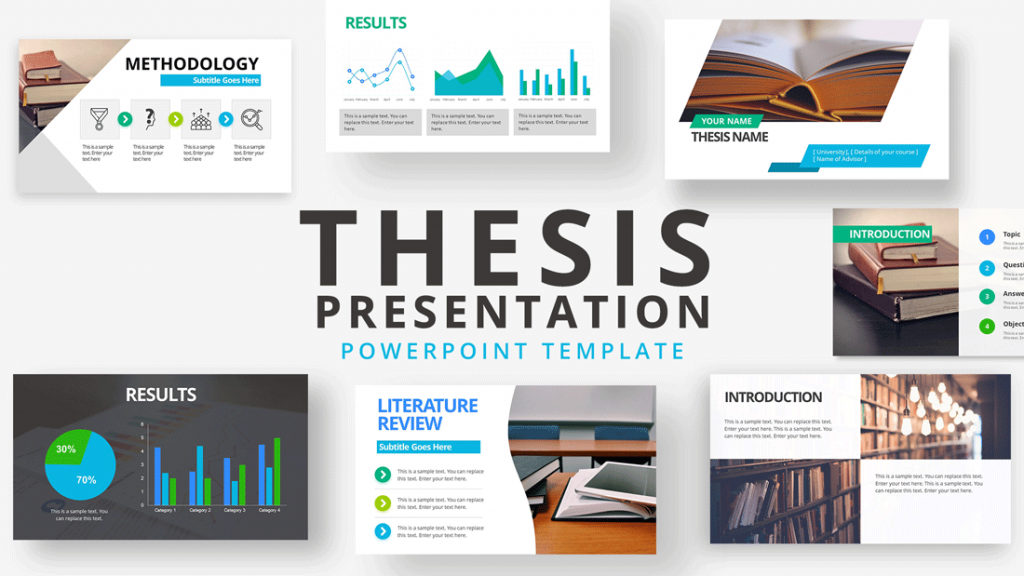
You had invested a considerable time researching, testing hypothesis and confirming your thesis. Craft your thesis presentation with the same level of detail you applied in your work. Using the Thesis Presentation PowerPoint Template you will focus only in your content and your message. The layouts, images,design and structure will be taken care by the template.
3. Master Thesis PowerPoint Template

The Master Thesis PowerPoint Template is a professional document designed for postgraduate degrees presentations. It provides simple sections that follow the structure and best practices of traditional research thesis presentations. Starting with the introduction to the theory and state of the art scenario; following with hypothesis research and its findings and concluding with the confirmation or negation of the initial thesis statement.
4. Essay Outline PowerPoint Template

Your thesis defense can be accompanied by an essay, that states your thesis and argues about it using several supporting paragraphs. This kind of document is ideal to be an intermediate step between reading assisting to the thesis presentation and reading the complete thesis documentation. It has more information that your thesis defense abstract, but does summarizes the supporting evidence and examples that allows the argument of each idea behind the thesis. You can use the Essay Outline Template to present your Essay outline and create an essay linked to your thesis defense documentation.
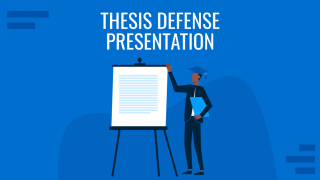
Like this article? Please share
Academics, Degree, Dissertation, Doctorate, Education, Faculty, Master, PhD, Student, Thesis Filed under Presentation Ideas
Related Articles

Filed under Presentation Ideas • November 9th, 2023
How to Create and Deliver a Research Presentation
Presentation is one of the final steps of a research endeavor. Learn how to make and deliver a research presentation using our templates and tips.

Filed under Education • September 10th, 2023
How To Write An Essay? – Where to start?
Do you wonder How to write an essay ? Start with the essay structure. This post describes the standard essay structure with its content, and which essay types are popular. Develop your writing skills using the best practices of Essay Structure.
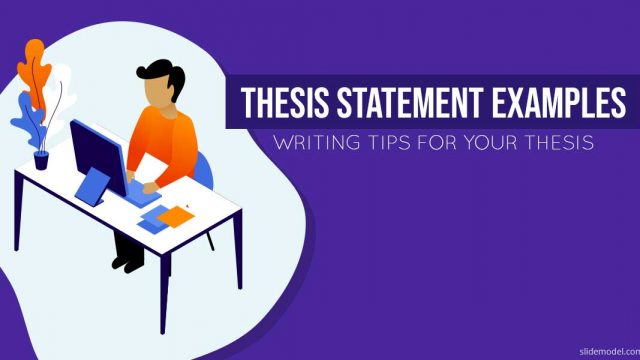
Filed under Education • September 2nd, 2023
Thesis Statement Examples
What makes a good thesis statement? Simple answer, precision and enough evidence to support your statement. In this article we analyze what are good thesis statements with examples.
36 Responses to “How To Do a Proper Thesis Defense Using the Right PowerPoint Presentation”
Great job! This has made my thesis presentation a whole lot easier.
Excellent !!!!!
Now I feel I’m quite confident on how to do my dissertation presentation properly and how to defend it. I will share that with other friends and colleagues.
Thank you so much for your kind help.
Best regards, Awad
Thank you for such a valuable guide.
it was very helpful
Thanks a bunch for the general summary for thesis defense with all related information that we might have to know. Great job!
Great tips.
i have proposal defense in two days and im so nervous right now! reading this is helpful in some ways thankyou!
It’s very helpful and understandable. Easy steps to follow.
I found it very helpful to refresh and make my self ready for my defense!
Thank you a lot this article. It’s really helpful!
Naveen Kumar S: Thank you its very Helpful. I appreciate all your effort this is very useful.
Very important and interesting so go on thank you
I really like it. In the near future I am going to present for the MA thesis. Therefore, it will guide me a lot. If you can please attach with this email the detail.
I do like the article as it proves to be valuable and worthy. I enjoyed reading every single note. It helped me feel at ease and have confidence when my viva day takes place. THANK YOU SO MUCH.
Appreciate your Assistance
Thanks a lot for the gist
Thank you so much, I got full information and knowledge.
This has made me look forward to my thesis defense. Thanks a lot
Very useful
thank you very much for your best information
Thank you very much the article is full of knowledge on Thesis as well as dissertation defense. Big Up!
I am appreciative. Well informative and educative.
Thanks immensely for these wonderful tips on presentation during defense. I personally found more useful to me as I prepare to defend my Master Dissertation.
Thank you very much! I now feel more confident.
Thanks for your good self overall usability of the Participations motivated points and contribute significantly in thesis defense practices. Best wishes to one and All
Happy To Help.
Thank you very much. As I am pursuing for my PhD in Leadership, I got it so meaningful and worth having.
Your tips on What a Thesis and Dissertation are, are on point. I have fully understood their differences and similarities. I have also noted the killer way of summaring a Power Point Presentation. Slidemodel.com…you are just a force to reckon with. I need more information…in case you have models you can share with me and those interested in this subject covered.
Thanks a million times for your timely guidance. Just preparing to do my PhD Thesis defense.
this was very, very helpful…Thank you!
Highly appreciate your effort to deliver what a student is looking for. I find your article really helpful and to the point. Thanks !
Regarding to my P.P, I’ve understood so many issues from this. Thankyou!
i got it as it is so important for my deffence presentation, thanky you very much
This Material was very hopeful and encourage any student who prepare any presentation relation with thesis. It also combined more encauragable and it enhance presentation!
Thought provoking content Thank you.
Great comments. very helpful
Leave a Reply
- Slidesgo School
- Presentation Tips
How to Start a Thesis Defense Presentation

After months and years of hard work, the moment to wrap things all up is finally here—your thesis defense presentation.
Whether you’re pursuing a master’s degree or doctorate, it’s the final step to that much-deserved achievement.
A thesis defense requires a lot of prior research and preparation. And as important as its content is, so is how you present it because a stunning design with clear data and text hierarchy plays an immense role in comprehension.
In this article, we’ll explore how you make your thesis defense .
The organization is the key to success. Establishing some previous steps before any project or work is essential for the result to be very positive. And the defense of a thesis could not be less.
Below, we will develop all the necessary steps to make a thesis defense presentation and we will give you some tips on how to carry them out.
How to Make an Amazing Presentation
Defining the concept of your thesis presentation, structuring your thesis defense presentation, how do you welcome the audience, tell them why you did this thesis, go into the content by explaining your thesis part by part, how to end the defense of the thesis.
After a long time of research and study, the content of your thesis is ready. Now, you have to find the best way to reflect all that effort behind your work. The information comes across more clearly if you use a visual format, as it attracts the attention of the audience. To present your thesis information in a clear, concise, and ultimately amazing way, you can use one of our unique thesis defense templates , available at Slidesgo.
As an example, in this article, we are going to use the Ecology Thesis template . With it, we will show you what to include in your presentation and how to make an attractive design.
After choosing the Google Slides and PowerPoint template that best suits the needs and subject matter of your thesis, it is time to define an overarching concept.
This is the main theme on which your designs are based. It must be relevant to your thesis as its purpose is to guide your selection of colors, typography, images, style, etc.
These must be portrayed in a way that supports the main message of your slides and should be aligned with your concept both visually and sociologically.
Once you have defined the concept, you will have to move on to the next step: structuring the content of your thesis. A good structure will show that there is a good organization behind the work, but most importantly: it will highlight your content.
In this article, we are going to show you a structure that could be a good example of how to structure a thesis, but you can adapt it to what your specific content requires.
Before you begin your thesis defense, you should welcome your audience. A good presentation will make you connect with your audience, which will result in more general interest in your work.
Use an appropriate language register (avoid informal language), but be approachable and natural.
"Welcome to the thesis defense on [the title of your thesis]". Next, introduce yourself with your name and give a short description of your background and occupation.
Don't forget to say “thank you for attending!”
To continue establishing that connection with your audience, explain the reasons that led you to do this thesis. Tell the professional reasons, and you can even say some personal ones, which will denote closeness, and your audience will appreciate it.
Now it's time to go into the content of the thesis ! After these preliminary steps, which are just as important as the thesis itself, it is time to explain part by part the structure (which you had previously established). We are going to propose a structure for your project, but the final decision is always yours!

First impressions are very important. Because your title page is the very first thing viewers see, it must be striking and impactful. It also sets the stage for the rest of your slides.
In one glance, the following should be established:
- Thesis defense topic
- Design style
For instance, the ecology thesis’s title page uses illustrations of a natural landscape to represent the topic of nature and a striking shade of blue to set the tone.
The sans serif font used depicts clean-cut typography and style and the thesis topic is written in large and bold typography, which draws attention to it immediately.
.jpg)
Right after your title page, include an introduction slide to provide more details about your topic.
This means explaining what you hope to answer with your research, its importance to your field, and why you chose it.
Continue to incorporate design elements relevant to your concept. This example has done just that by using a different natural landscape and including animals. For coherence, stick to the same typography and style throughout your presentation.
.jpg)
The aim of the literature review slide is to illustrate your knowledge of your thesis topic and any relevant theories.
Walls of text kill a design. For clarity, we recommend presenting this with bullet points. Each one should be short and sweet and only touch on the basics; you can elaborate on them in your speech.
Don’t forget to be consistent with your design. In our example, we’ve maintained the tone of blue chosen and added illustrations of leaves in the far corners of the slide.
Also, address similar research that has been done. This is to showcase your topic’s originality and, if relevant, how it’s different and/or an improvement from previously done research.
.jpg)
This is one of the most important parts of a thesis defense presentation.
It allows your viewers to assess the rationality and validity of your approach and consequently, the accuracy of your results.
A great methodology slide explains the what , how, and why :
- What method did you use for your research
- Why did you choose it
- How did you conduct it
Because this part of your thesis will be rather technical, the most effective way to aid understanding is by using graphics like charts and tables.
.jpg)
Keep text to a minimum to avoid drawing attention away from the graphics. If there is a text that must absolutely be included, consider using bullet points and keep them short.
Don’t forget to maintain color, style, and typography coherence.
.jpg)
The results slides are easily the most quantitative part of a thesis defense.
Here, your aim is to simply introduce your findings. Select the most impactful data and highlight them here.
Just as with methodology, use graphics like charts, tables, and graphs to portray the data in a clear way. And, once again, try not to write too much text. Let the visual content do the talking .
.jpg)
After you’ve introduced your data, the next step would be to help your audience make sense of it. That means understanding what it means in the context of your thesis research topic and your discipline.
Simply put, you should answer the question: What do the numbers mean?
The best way to approach this would be to do it as if you were creating an infographic .
Illustrations like icons are a quick and simple way to represent your message. It also reduces the amount of text on your slide, which makes the information much more digestible.
For a balanced thesis presentation, you should also address any outliers and anomalies.
To quote bestselling author Robin Sharma, “Starting strong is good. Finishing strong is epic.”
That’s exactly what to aim for in your conclusion.
Provide an overview of your thesis topic and remind your audience what you set out to answer with your research. In our example, we’ve used three icons accompanied by a short title and text.
.jpg)
Following that, reiterate the important points of your research results you want your audience to take away from your thesis defense presentation.
You can do so by expanding the next slide to have more icons and points, for example.
.jpg)
Don’t forget to address any shortcomings and limitations in your approach and extra points for suggesting possible improvements for future research.
We are going to give you a little tip to make your thesis defense a success. You can combine your defense with good public speaking techniques. Take a look at our article "How to become a great speaker" .
We hope this article has been of great help, have you already seen our templates to make the presentation of your thesis ? Choose the one that best suits your needs, we are sure that one of them will go perfectly with your thesis presentation!
Good luck from Slidesgo.

Do you find this article useful?
Related tutorials.

7 tips to create a positive classroom culture
No matter if it's been ages since you last stepped into a classroom or just a long time ago―there’s probably a particular learning experience you often find yourself thinking about. Maybe it was a passionate teacher who kept the whole class engaged, or perhaps a classmate who lent you a hand with a tricky topic. Positive classroom experiences do leave a lasting mark on us, so it makes perfect sense that people leading a classroom aim to create the finest possible learning setting. In this article, we’ll share some tips to help you turn a regular classroom into a positive space.

How to create a word cloud in Google Slides
There are many ways to improve your Google Slides presentation. From choosing the right font to finding the right template, good presentations keep an audience engaged and convey a message in a clear way.Knowing how to visualize data in a slideshow is one of those actions that have a huge impact on the success of a presentation. At the end of the day, plain data fails to motivate decisions as effectively as clear insights do. This is when powerful visual tools like word clouds step in. Let us tell you all about them.

How to create a word cloud in PowerPoint
In the age of information, showing data has become as important as collecting it. Those who are able to turn big amounts of data into easy-to-understand ideas, are the ones pushing the game forward.At the end of the day, plain data fails to motivate decisions as much as clear insights do. That’s where powerful visual tools such as word clouds step in. We’re here to tell you all about them.

Welcome to Slidesgo Educator Community, Community Circle!
As educators, it's essential to support collaboration and professional development among peers. However, the demands of educating students can sometimes make it challenging to find the time to network with fellow educators. That's why we're excited to introduce our Slidesgo Educator Community, an innovative platform designed especially for educators. In this blog post, we'll dive deeper into why we created this community, what its key features are, and how it can benefit educators.
Have a language expert improve your writing
Run a free plagiarism check in 10 minutes, automatically generate references for free.
- Knowledge Base
- Dissertation
How to Write a Dissertation Proposal | A Step-by-Step Guide
Published on 14 February 2020 by Jack Caulfield . Revised on 11 November 2022.
A dissertation proposal describes the research you want to do: what it’s about, how you’ll conduct it, and why it’s worthwhile. You will probably have to write a proposal before starting your dissertation as an undergraduate or postgraduate student.
A dissertation proposal should generally include:
- An introduction to your topic and aims
- A literature review of the current state of knowledge
- An outline of your proposed methodology
- A discussion of the possible implications of the research
- A bibliography of relevant sources
Dissertation proposals vary a lot in terms of length and structure, so make sure to follow any guidelines given to you by your institution, and check with your supervisor when you’re unsure.
Instantly correct all language mistakes in your text
Be assured that you'll submit flawless writing. Upload your document to correct all your mistakes.

Table of contents
Step 1: coming up with an idea, step 2: presenting your idea in the introduction, step 3: exploring related research in the literature review, step 4: describing your methodology, step 5: outlining the potential implications of your research, step 6: creating a reference list or bibliography.
Before writing your proposal, it’s important to come up with a strong idea for your dissertation.
Find an area of your field that interests you and do some preliminary reading in that area. What are the key concerns of other researchers? What do they suggest as areas for further research, and what strikes you personally as an interesting gap in the field?
Once you have an idea, consider how to narrow it down and the best way to frame it. Don’t be too ambitious or too vague – a dissertation topic needs to be specific enough to be feasible. Move from a broad field of interest to a specific niche:
- Russian literature 19th century Russian literature The novels of Tolstoy and Dostoevsky
- Social media Mental health effects of social media Influence of social media on young adults suffering from anxiety
Prevent plagiarism, run a free check.
Like most academic texts, a dissertation proposal begins with an introduction . This is where you introduce the topic of your research, provide some background, and most importantly, present your aim , objectives and research question(s) .
Try to dive straight into your chosen topic: What’s at stake in your research? Why is it interesting? Don’t spend too long on generalisations or grand statements:
- Social media is the most important technological trend of the 21st century. It has changed the world and influences our lives every day.
- Psychologists generally agree that the ubiquity of social media in the lives of young adults today has a profound impact on their mental health. However, the exact nature of this impact needs further investigation.
Once your area of research is clear, you can present more background and context. What does the reader need to know to understand your proposed questions? What’s the current state of research on this topic, and what will your dissertation contribute to the field?
If you’re including a literature review, you don’t need to go into too much detail at this point, but give the reader a general sense of the debates that you’re intervening in.
This leads you into the most important part of the introduction: your aim, objectives and research question(s) . These should be clearly identifiable and stand out from the text – for example, you could present them using bullet points or bold font.
Make sure that your research questions are specific and workable – something you can reasonably answer within the scope of your dissertation. Avoid being too broad or having too many different questions. Remember that your goal in a dissertation proposal is to convince the reader that your research is valuable and feasible:
- Does social media harm mental health?
- What is the impact of daily social media use on 18– to 25–year–olds suffering from general anxiety disorder?
Now that your topic is clear, it’s time to explore existing research covering similar ideas. This is important because it shows you what is missing from other research in the field and ensures that you’re not asking a question someone else has already answered.
You’ve probably already done some preliminary reading, but now that your topic is more clearly defined, you need to thoroughly analyse and evaluate the most relevant sources in your literature review .
Here you should summarise the findings of other researchers and comment on gaps and problems in their studies. There may be a lot of research to cover, so make effective use of paraphrasing to write concisely:
- Smith and Prakash state that ‘our results indicate a 25% decrease in the incidence of mechanical failure after the new formula was applied’.
- Smith and Prakash’s formula reduced mechanical failures by 25%.
The point is to identify findings and theories that will influence your own research, but also to highlight gaps and limitations in previous research which your dissertation can address:
- Subsequent research has failed to replicate this result, however, suggesting a flaw in Smith and Prakash’s methods. It is likely that the failure resulted from…
Next, you’ll describe your proposed methodology : the specific things you hope to do, the structure of your research and the methods that you will use to gather and analyse data.
You should get quite specific in this section – you need to convince your supervisor that you’ve thought through your approach to the research and can realistically carry it out. This section will look quite different, and vary in length, depending on your field of study.
You may be engaged in more empirical research, focusing on data collection and discovering new information, or more theoretical research, attempting to develop a new conceptual model or add nuance to an existing one.
Dissertation research often involves both, but the content of your methodology section will vary according to how important each approach is to your dissertation.
Empirical research
Empirical research involves collecting new data and analysing it in order to answer your research questions. It can be quantitative (focused on numbers), qualitative (focused on words and meanings), or a combination of both.
With empirical research, it’s important to describe in detail how you plan to collect your data:
- Will you use surveys ? A lab experiment ? Interviews?
- What variables will you measure?
- How will you select a representative sample ?
- If other people will participate in your research, what measures will you take to ensure they are treated ethically?
- What tools (conceptual and physical) will you use, and why?
It’s appropriate to cite other research here. When you need to justify your choice of a particular research method or tool, for example, you can cite a text describing the advantages and appropriate usage of that method.
Don’t overdo this, though; you don’t need to reiterate the whole theoretical literature, just what’s relevant to the choices you have made.
Moreover, your research will necessarily involve analysing the data after you have collected it. Though you don’t know yet what the data will look like, it’s important to know what you’re looking for and indicate what methods (e.g. statistical tests , thematic analysis ) you will use.
Theoretical research
You can also do theoretical research that doesn’t involve original data collection. In this case, your methodology section will focus more on the theory you plan to work with in your dissertation: relevant conceptual models and the approach you intend to take.
For example, a literary analysis dissertation rarely involves collecting new data, but it’s still necessary to explain the theoretical approach that will be taken to the text(s) under discussion, as well as which parts of the text(s) you will focus on:
- This dissertation will utilise Foucault’s theory of panopticism to explore the theme of surveillance in Orwell’s 1984 and Kafka’s The Trial…
Here, you may refer to the same theorists you have already discussed in the literature review. In this case, the emphasis is placed on how you plan to use their contributions in your own research.
You’ll usually conclude your dissertation proposal with a section discussing what you expect your research to achieve.
You obviously can’t be too sure: you don’t know yet what your results and conclusions will be. Instead, you should describe the projected implications and contribution to knowledge of your dissertation.
First, consider the potential implications of your research. Will you:
- Develop or test a theory?
- Provide new information to governments or businesses?
- Challenge a commonly held belief?
- Suggest an improvement to a specific process?
Describe the intended result of your research and the theoretical or practical impact it will have:
Finally, it’s sensible to conclude by briefly restating the contribution to knowledge you hope to make: the specific question(s) you hope to answer and the gap the answer(s) will fill in existing knowledge:
Like any academic text, it’s important that your dissertation proposal effectively references all the sources you have used. You need to include a properly formatted reference list or bibliography at the end of your proposal.
Different institutions recommend different styles of referencing – commonly used styles include Harvard , Vancouver , APA , or MHRA . If your department does not have specific requirements, choose a style and apply it consistently.
A reference list includes only the sources that you cited in your proposal. A bibliography is slightly different: it can include every source you consulted in preparing the proposal, even if you didn’t mention it in the text. In the case of a dissertation proposal, a bibliography may also list relevant sources that you haven’t yet read, but that you intend to use during the research itself.
Check with your supervisor what type of bibliography or reference list you should include.
Cite this Scribbr article
If you want to cite this source, you can copy and paste the citation or click the ‘Cite this Scribbr article’ button to automatically add the citation to our free Reference Generator.
Caulfield, J. (2022, November 11). How to Write a Dissertation Proposal | A Step-by-Step Guide. Scribbr. Retrieved 2 April 2024, from https://www.scribbr.co.uk/thesis-dissertation/proposal/
Is this article helpful?

Jack Caulfield
Other students also liked, what is a dissertation | 5 essential questions to get started, what is a literature review | guide, template, & examples, what is a research methodology | steps & tips.

- Publication Recognition
How to Make a PowerPoint Presentation of Your Research Paper
- 4 minute read
- 117.8K views
Table of Contents
A research paper presentation is often used at conferences and in other settings where you have an opportunity to share your research, and get feedback from your colleagues. Although it may seem as simple as summarizing your research and sharing your knowledge, successful research paper PowerPoint presentation examples show us that there’s a little bit more than that involved.
In this article, we’ll highlight how to make a PowerPoint presentation from a research paper, and what to include (as well as what NOT to include). We’ll also touch on how to present a research paper at a conference.
Purpose of a Research Paper Presentation
The purpose of presenting your paper at a conference or forum is different from the purpose of conducting your research and writing up your paper. In this setting, you want to highlight your work instead of including every detail of your research. Likewise, a presentation is an excellent opportunity to get direct feedback from your colleagues in the field. But, perhaps the main reason for presenting your research is to spark interest in your work, and entice the audience to read your research paper.
So, yes, your presentation should summarize your work, but it needs to do so in a way that encourages your audience to seek out your work, and share their interest in your work with others. It’s not enough just to present your research dryly, to get information out there. More important is to encourage engagement with you, your research, and your work.
Tips for Creating Your Research Paper Presentation
In addition to basic PowerPoint presentation recommendations, which we’ll cover later in this article, think about the following when you’re putting together your research paper presentation:
- Know your audience : First and foremost, who are you presenting to? Students? Experts in your field? Potential funders? Non-experts? The truth is that your audience will probably have a bit of a mix of all of the above. So, make sure you keep that in mind as you prepare your presentation.
Know more about: Discover the Target Audience .
- Your audience is human : In other words, they may be tired, they might be wondering why they’re there, and they will, at some point, be tuning out. So, take steps to help them stay interested in your presentation. You can do that by utilizing effective visuals, summarize your conclusions early, and keep your research easy to understand.
- Running outline : It’s not IF your audience will drift off, or get lost…it’s WHEN. Keep a running outline, either within the presentation or via a handout. Use visual and verbal clues to highlight where you are in the presentation.
- Where does your research fit in? You should know of work related to your research, but you don’t have to cite every example. In addition, keep references in your presentation to the end, or in the handout. Your audience is there to hear about your work.
- Plan B : Anticipate possible questions for your presentation, and prepare slides that answer those specific questions in more detail, but have them at the END of your presentation. You can then jump to them, IF needed.
What Makes a PowerPoint Presentation Effective?
You’ve probably attended a presentation where the presenter reads off of their PowerPoint outline, word for word. Or where the presentation is busy, disorganized, or includes too much information. Here are some simple tips for creating an effective PowerPoint Presentation.
- Less is more: You want to give enough information to make your audience want to read your paper. So include details, but not too many, and avoid too many formulas and technical jargon.
- Clean and professional : Avoid excessive colors, distracting backgrounds, font changes, animations, and too many words. Instead of whole paragraphs, bullet points with just a few words to summarize and highlight are best.
- Know your real-estate : Each slide has a limited amount of space. Use it wisely. Typically one, no more than two points per slide. Balance each slide visually. Utilize illustrations when needed; not extraneously.
- Keep things visual : Remember, a PowerPoint presentation is a powerful tool to present things visually. Use visual graphs over tables and scientific illustrations over long text. Keep your visuals clean and professional, just like any text you include in your presentation.
Know more about our Scientific Illustrations Services .
Another key to an effective presentation is to practice, practice, and then practice some more. When you’re done with your PowerPoint, go through it with friends and colleagues to see if you need to add (or delete excessive) information. Double and triple check for typos and errors. Know the presentation inside and out, so when you’re in front of your audience, you’ll feel confident and comfortable.
How to Present a Research Paper
If your PowerPoint presentation is solid, and you’ve practiced your presentation, that’s half the battle. Follow the basic advice to keep your audience engaged and interested by making eye contact, encouraging questions, and presenting your information with enthusiasm.
We encourage you to read our articles on how to present a scientific journal article and tips on giving good scientific presentations .
Language Editing Plus
Improve the flow and writing of your research paper with Language Editing Plus. This service includes unlimited editing, manuscript formatting for the journal of your choice, reference check and even a customized cover letter. Learn more here , and get started today!

- Manuscript Preparation
Know How to Structure Your PhD Thesis

- Research Process
Systematic Literature Review or Literature Review?
You may also like.

What is a Good H-index?

What is a Corresponding Author?

How to Submit a Paper for Publication in a Journal
Input your search keywords and press Enter.
What (Exactly) Is A Research Proposal?
A simple explainer with examples + free template.
By: Derek Jansen (MBA) | Reviewed By: Dr Eunice Rautenbach | June 2020 (Updated April 2023)
Whether you’re nearing the end of your degree and your dissertation is on the horizon, or you’re planning to apply for a PhD program, chances are you’ll need to craft a convincing research proposal . If you’re on this page, you’re probably unsure exactly what the research proposal is all about. Well, you’ve come to the right place.
Overview: Research Proposal Basics
- What a research proposal is
- What a research proposal needs to cover
- How to structure your research proposal
- Example /sample proposals
- Proposal writing FAQs
- Key takeaways & additional resources
What is a research proposal?
Simply put, a research proposal is a structured, formal document that explains what you plan to research (your research topic), why it’s worth researching (your justification), and how you plan to investigate it (your methodology).
The purpose of the research proposal (its job, so to speak) is to convince your research supervisor, committee or university that your research is suitable (for the requirements of the degree program) and manageable (given the time and resource constraints you will face).
The most important word here is “ convince ” – in other words, your research proposal needs to sell your research idea (to whoever is going to approve it). If it doesn’t convince them (of its suitability and manageability), you’ll need to revise and resubmit . This will cost you valuable time, which will either delay the start of your research or eat into its time allowance (which is bad news).

What goes into a research proposal?
A good dissertation or thesis proposal needs to cover the “ what “, “ why ” and” how ” of the proposed study. Let’s look at each of these attributes in a little more detail:
Your proposal needs to clearly articulate your research topic . This needs to be specific and unambiguous . Your research topic should make it clear exactly what you plan to research and in what context. Here’s an example of a well-articulated research topic:
An investigation into the factors which impact female Generation Y consumer’s likelihood to promote a specific makeup brand to their peers: a British context
As you can see, this topic is extremely clear. From this one line we can see exactly:
- What’s being investigated – factors that make people promote or advocate for a brand of a specific makeup brand
- Who it involves – female Gen-Y consumers
- In what context – the United Kingdom
So, make sure that your research proposal provides a detailed explanation of your research topic . If possible, also briefly outline your research aims and objectives , and perhaps even your research questions (although in some cases you’ll only develop these at a later stage). Needless to say, don’t start writing your proposal until you have a clear topic in mind , or you’ll end up waffling and your research proposal will suffer as a result of this.
Need a helping hand?
As we touched on earlier, it’s not good enough to simply propose a research topic – you need to justify why your topic is original . In other words, what makes it unique ? What gap in the current literature does it fill? If it’s simply a rehash of the existing research, it’s probably not going to get approval – it needs to be fresh.
But, originality alone is not enough. Once you’ve ticked that box, you also need to justify why your proposed topic is important . In other words, what value will it add to the world if you achieve your research aims?
As an example, let’s look at the sample research topic we mentioned earlier (factors impacting brand advocacy). In this case, if the research could uncover relevant factors, these findings would be very useful to marketers in the cosmetics industry, and would, therefore, have commercial value . That is a clear justification for the research.
So, when you’re crafting your research proposal, remember that it’s not enough for a topic to simply be unique. It needs to be useful and value-creating – and you need to convey that value in your proposal. If you’re struggling to find a research topic that makes the cut, watch our video covering how to find a research topic .

It’s all good and well to have a great topic that’s original and valuable, but you’re not going to convince anyone to approve it without discussing the practicalities – in other words:
- How will you actually undertake your research (i.e., your methodology)?
- Is your research methodology appropriate given your research aims?
- Is your approach manageable given your constraints (time, money, etc.)?
While it’s generally not expected that you’ll have a fully fleshed-out methodology at the proposal stage, you’ll likely still need to provide a high-level overview of your research methodology . Here are some important questions you’ll need to address in your research proposal:
- Will you take a qualitative , quantitative or mixed -method approach?
- What sampling strategy will you adopt?
- How will you collect your data (e.g., interviews, surveys, etc)?
- How will you analyse your data (e.g., descriptive and inferential statistics , content analysis, discourse analysis, etc, .)?
- What potential limitations will your methodology carry?
So, be sure to give some thought to the practicalities of your research and have at least a basic methodological plan before you start writing up your proposal. If this all sounds rather intimidating, the video below provides a good introduction to research methodology and the key choices you’ll need to make.
How To Structure A Research Proposal
Now that we’ve covered the key points that need to be addressed in a proposal, you may be wondering, “ But how is a research proposal structured? “.
While the exact structure and format required for a research proposal differs from university to university, there are four “essential ingredients” that commonly make up the structure of a research proposal:
- A rich introduction and background to the proposed research
- An initial literature review covering the existing research
- An overview of the proposed research methodology
- A discussion regarding the practicalities (project plans, timelines, etc.)
In the video below, we unpack each of these four sections, step by step.
Research Proposal Examples/Samples
In the video below, we provide a detailed walkthrough of two successful research proposals (Master’s and PhD-level), as well as our popular free proposal template.
Proposal Writing FAQs
How long should a research proposal be.
This varies tremendously, depending on the university, the field of study (e.g., social sciences vs natural sciences), and the level of the degree (e.g. undergraduate, Masters or PhD) – so it’s always best to check with your university what their specific requirements are before you start planning your proposal.
As a rough guide, a formal research proposal at Masters-level often ranges between 2000-3000 words, while a PhD-level proposal can be far more detailed, ranging from 5000-8000 words. In some cases, a rough outline of the topic is all that’s needed, while in other cases, universities expect a very detailed proposal that essentially forms the first three chapters of the dissertation or thesis.
The takeaway – be sure to check with your institution before you start writing.
How do I choose a topic for my research proposal?
Finding a good research topic is a process that involves multiple steps. We cover the topic ideation process in this video post.
How do I write a literature review for my proposal?
While you typically won’t need a comprehensive literature review at the proposal stage, you still need to demonstrate that you’re familiar with the key literature and are able to synthesise it. We explain the literature review process here.
How do I create a timeline and budget for my proposal?
We explain how to craft a project plan/timeline and budget in Research Proposal Bootcamp .
Which referencing format should I use in my research proposal?
The expectations and requirements regarding formatting and referencing vary from institution to institution. Therefore, you’ll need to check this information with your university.
What common proposal writing mistakes do I need to look out for?
We’ve create a video post about some of the most common mistakes students make when writing a proposal – you can access that here . If you’re short on time, here’s a quick summary:
- The research topic is too broad (or just poorly articulated).
- The research aims, objectives and questions don’t align.
- The research topic is not well justified.
- The study has a weak theoretical foundation.
- The research design is not well articulated well enough.
- Poor writing and sloppy presentation.
- Poor project planning and risk management.
- Not following the university’s specific criteria.
Key Takeaways & Additional Resources
As you write up your research proposal, remember the all-important core purpose: to convince . Your research proposal needs to sell your study in terms of suitability and viability. So, focus on crafting a convincing narrative to ensure a strong proposal.
At the same time, pay close attention to your university’s requirements. While we’ve covered the essentials here, every institution has its own set of expectations and it’s essential that you follow these to maximise your chances of approval.
By the way, we’ve got plenty more resources to help you fast-track your research proposal. Here are some of our most popular resources to get you started:
- Proposal Writing 101 : A Introductory Webinar
- Research Proposal Bootcamp : The Ultimate Online Course
- Template : A basic template to help you craft your proposal
If you’re looking for 1-on-1 support with your research proposal, be sure to check out our private coaching service , where we hold your hand through the proposal development process (and the entire research journey), step by step.

Psst… there’s more!
This post is an extract from our bestselling Udemy Course, Research Proposal Bootcamp . If you want to work smart, you don't want to miss this .
You Might Also Like:

51 Comments
I truly enjoyed this video, as it was eye-opening to what I have to do in the preparation of preparing a Research proposal.
I would be interested in getting some coaching.
I real appreciate on your elaboration on how to develop research proposal,the video explains each steps clearly.
Thank you for the video. It really assisted me and my niece. I am a PhD candidate and she is an undergraduate student. It is at times, very difficult to guide a family member but with this video, my job is done.
In view of the above, I welcome more coaching.
Wonderful guidelines, thanks
This is very helpful. Would love to continue even as I prepare for starting my masters next year.
Thanks for the work done, the text was helpful to me
Bundle of thanks to you for the research proposal guide it was really good and useful if it is possible please send me the sample of research proposal
You’re most welcome. We don’t have any research proposals that we can share (the students own the intellectual property), but you might find our research proposal template useful: https://gradcoach.com/research-proposal-template/
Cheruiyot Moses Kipyegon
Thanks alot. It was an eye opener that came timely enough before my imminent proposal defense. Thanks, again
thank you very much your lesson is very interested may God be with you
I am an undergraduate student (First Degree) preparing to write my project,this video and explanation had shed more light to me thanks for your efforts keep it up.
Very useful. I am grateful.
this is a very a good guidance on research proposal, for sure i have learnt something
Wonderful guidelines for writing a research proposal, I am a student of m.phil( education), this guideline is suitable for me. Thanks
You’re welcome 🙂
Thank you, this was so helpful.
A really great and insightful video. It opened my eyes as to how to write a research paper. I would like to receive more guidance for writing my research paper from your esteemed faculty.
Thank you, great insights
Thank you, great insights, thank you so much, feeling edified
Wow thank you, great insights, thanks a lot
Thank you. This is a great insight. I am a student preparing for a PhD program. I am requested to write my Research Proposal as part of what I am required to submit before my unconditional admission. I am grateful having listened to this video which will go a long way in helping me to actually choose a topic of interest and not just any topic as well as to narrow down the topic and be specific about it. I indeed need more of this especially as am trying to choose a topic suitable for a DBA am about embarking on. Thank you once more. The video is indeed helpful.
Have learnt a lot just at the right time. Thank you so much.
thank you very much ,because have learn a lot things concerning research proposal and be blessed u for your time that you providing to help us
Hi. For my MSc medical education research, please evaluate this topic for me: Training Needs Assessment of Faculty in Medical Training Institutions in Kericho and Bomet Counties
I have really learnt a lot based on research proposal and it’s formulation
Thank you. I learn much from the proposal since it is applied
Your effort is much appreciated – you have good articulation.
You have good articulation.
I do applaud your simplified method of explaining the subject matter, which indeed has broaden my understanding of the subject matter. Definitely this would enable me writing a sellable research proposal.
This really helping
Great! I liked your tutoring on how to find a research topic and how to write a research proposal. Precise and concise. Thank you very much. Will certainly share this with my students. Research made simple indeed.
Thank you very much. I an now assist my students effectively.
Thank you very much. I can now assist my students effectively.
I need any research proposal
Thank you for these videos. I will need chapter by chapter assistance in writing my MSc dissertation
Very helpfull
the videos are very good and straight forward
thanks so much for this wonderful presentations, i really enjoyed it to the fullest wish to learn more from you
Thank you very much. I learned a lot from your lecture.
I really enjoy the in-depth knowledge on research proposal you have given. me. You have indeed broaden my understanding and skills. Thank you
interesting session this has equipped me with knowledge as i head for exams in an hour’s time, am sure i get A++
This article was most informative and easy to understand. I now have a good idea of how to write my research proposal.
Thank you very much.
Wow, this literature is very resourceful and interesting to read. I enjoyed it and I intend reading it every now then.
Thank you for the clarity
Thank you. Very helpful.
Thank you very much for this essential piece. I need 1o1 coaching, unfortunately, your service is not available in my country. Anyways, a very important eye-opener. I really enjoyed it. A thumb up to Gradcoach
What is JAM? Please explain.
Thank you so much for these videos. They are extremely helpful! God bless!
very very wonderful…
thank you for the video but i need a written example
Submit a Comment Cancel reply
Your email address will not be published. Required fields are marked *
Save my name, email, and website in this browser for the next time I comment.
- Print Friendly
How to Create an Effective Dissertation Presentation
For many students, the task of writing a lengthy dissertation is so daunting that they forget about the need for Dissertation Presentation! Amidst all the hard work of researching and writing, students in some courses still need to prepare for a high-quality presentation that will help them earn top marks. This article will help you prepare and give you some essential tips for success.
The Purpose of Dissertation Presentation
There are two main types of Dissertation Presentation that are normally encountered in UK universities:
Mid-Research Presentations
Students will often be asked to present their dissertation work at a mid-point in their research. These presentations are usually made to a panel comprised of various faculty members from your department. In addition, they are sometimes structured as a postgraduate seminar, in which fellow students also attend. Both faculty and students can pose questions. The purpose of these Mid-Research Dissertation presentations is to provide students with an opportunity to demonstrate their progress and identify any weak areas that need to be addressed.
Assessment Presentations
Students are also sometimes required to make a Dissertation Presentation as part of their overall assessment . This is a much more formal presentation than the Mid-Research one, and it is usually open only to the student, examiners and the research supervisor. During an Assessment Dissertation Presentation, the student is required to present a summary of their research and results. They will then be asked questions by the examiners in a somewhat lengthy oral examination. The purpose of this Dissertation Presentation is to assess the student’s original research project and test its scholarly validity.
Differences in Undergraduate and Masters Presentations
Dissertation Presentations may be required at both Undergraduate (Bachelors) and Postgraduate (Masters) levels. The key difference between these levels is the length and degree of originality expected. Postgraduate Dissertation Presentations will normally be longer than Undergraduate Presentations, and they will demonstrate a greater degree of critical engagement with the subject matter. They will also demonstrate some degree of original thinking. By contrast, most Bachelors Dissertation Presentations will be shorter in length and will only require a thorough knowledge of the topic rather than an original scholarly contribution of any kind.
What to Include
- Broad subject area – What subject area of your discipline does your work fall into?
- Narrow topic area – Within this subject area, what is your specific topic? (This may be simply an expanded discussion of your research title).
- Relevant Existing Studies – What studies have already been done on your specific topic? What are their strengths and weaknesses? How does your work fit among them?
- Methodology and Philosophy – What methodology have you chosen to conduct your research? Is there a specific philosophical context? Why is this a good approach?
- Project Resources – If this is a Mid-Research Presentation, what resources do you require to complete the project? Furthermore, have you identified likely sources of funding, or do you need any difficult-to-acquire materials?
- Case Studies – If you’ve conducted practical fieldwork or lab research, why did you choose these cases or projects? How are they the best choices for researching your topic?
- Research Results – If this is a Dissertation Presentation for Assessment, note the results of your research in detail. Relate these back to your theoretical framework and discuss how the results support or contradict existing studies.
How to Prepare for your Dissertation Presentation
The best way to prepare for your Dissertation Presentation is to review your work carefully. Take notes of the key decisions you have made throughout your research and the scholarly literature that supports these choices. Make sure that you have a thorough understanding of the scholarly context of your research, which should have been achieved in your early research stages.
Once your content has been written, you should create a PowerPoint presentation to use during your talk. Don’t forget the slides should be informative but not wordy – keep bullet points concise and use pictures sparingly. Make sure that you rehearse your presentation several times.
What Sort of Questions to Prepare For Dissertation Presentation
The questions you will face in a Dissertation Presentation are designed to test your knowledge of the subject area and your awareness of the context of your work. You will be asked questions to determine how well you understand the potential criticisms of your project, and how well you are able to defend this. Therefore, remember to reference established scholars and existing research.
You might be asked about the specific choices you’re made with regard to methodology and case studies, and how you accounted for any possible inaccuracies in your resulting data. Similarly, examiners frequently ask students what they would do differently if they were starting the same project again.
You should also be prepared to answer questions about the ways your research might be applied within your field, and how it might be supplemented in future. This is an effective way for examiners to assess the originality of your research, and consider its potential impact on your subject area.
How to Earn a High Mark
Much of your dissertation mark will come from the written work and the research project it represents. However, a good Dissertation Presentation will help make a strong case for a good overall mark, whereas a weak Presentation will confirm any doubts in the examiners’ minds. As such, here are a few key areas for success:
- Good Presentation Skills. As with any Presentation, it is important to speak clearly and concisely. Stand still and look your audience in the eye, and try not to rely too much on notes. Be sure to keep breathing and don’t rush your words!
- Knowledge of the Topic. If you truly have a good understanding of your topic you will be likely to do very well. Remember, much of the Dissertation Presentation is designed simply to test your knowledge. If you’ve kept pace with your reading assignments and practical work you should have no problem answering any questions that are posed to you.
- Professional Behaviour. Stay calm and focused during your Presentation, and answer any questions with objectivity and professionalism. Don’t be drawn into debates, but instead offer references to other scholars whose work supports your own agenda.
- Take Your Time . Many students make the mistake of rushing through their material and answering questions too quickly. This doesn’t give the audience a chance to thoroughly understand the quality of your work. Furthermore, it risks leaving out essential information and neglecting to demonstrate the depth of your research.
You may also like

- Graduate School
How to Write a Master's Thesis Proposal

How to write a master’s thesis proposal is one of the most-asked questions by graduate students. A master's thesis proposal involves a copious amount of data collection, particular presentation ethics, and most importantly, it will become the roadmap to your full thesis. Remember, you must convince your committee that your idea is strong and unique, and that you have done enough legwork to begin with the first few drafts of your final thesis. Your proposal should serve as a foundational blueprint on which you will later build your entire project. To have the perfect thesis proposal, you need to have original ideas, solid information, and proper presentation. While it is a good idea to take assistance from thesis writing services , you still need to personally understand the elements that contribute to a master’s thesis proposal worthy of approval. In this blog, we will discuss the process of writing your master’s thesis proposal and give you tips for making your proposal strong. Stay tuned!
>> Want us to help you get accepted? Schedule a free strategy call here . <<
Article Contents 8 min read
How to decide the goals for your master's thesis.
If you are pursuing a master’s or a PhD , you will be undertaking a major research paper or a thesis. Thus, writing a thesis proposal becomes inevitable. Your major objective for pursuing a master’s degree is to improve your knowledge in your field of study. When you start your degree, you delve deeper into different concepts in your discipline and try to search for answers to all kinds of questions. If you come across a question that no one can answer, you can select that question as your research thesis topic.
A master's thesis proposal will have multiple sections depending on your decided layout. These sections will continuously support your argument and try to convince the reader of your core argument. The structure will also help you arrange the various parts of the paper to have a greater impact on the readers. A paper should always begin with you giving a brief summary of the topic and how you have come across it. The introduction is particularly important because it will give the readers a brief idea about the topic of discussion and win their interest in the matter.
After the summary has been given, slowly you need to progress into the body of the thesis proposal which would explain your argument, research methodology, literary texts that have a relation to the topic, and the conclusion of your study. It would be similar to an essay or a literary review consisting of 3 or 4 parts. The bibliography will be placed at the end of the paper so that people can cross-check your sources.
Let's take a look at the sections most master's thesis proposals should cover. Please note that each university has its own guidelines for how to structure and what to include in a master’s thesis proposal. The outline we provide below is general, so please make sure to follow the exact guidelines provided by your school:
Restate your primary argument and give us a glimpse of what you will include in the main master\u2019s thesis. Leave the reader wanting more. Your research proposal should talk about what research chapters you are trying to undertake in your final thesis. You can also mention the proposed time in which you will complete these chapters. ","label":"Conclusion and proposed chapters","title":"Conclusion and proposed chapters"}]" code="tab1" template="BlogArticle">
A thesis proposal needs to be convincing enough to get approval. If the information is not enough to satisfy the evaluation committee, it would require revision. Hence, you need to select and follow the right methodology to make your argument convincing. When a research proposal is presented, the reader will determine the validity of your argument by judging the strength of your evidence and conclusions. Therefore, even writige:ng a proposal will require extensive research on your part. You should start writing your thesis proposal by working through the following steps.
Interested in a summary of the points covered below? Check out this infographic:
Exploring your topic in detail
You need to delve deeper into your chosen topic to see if your idea is original. In the process of this exploration, you will find tons of materials that will be supportive of your argument. When choosing your research topic and the problem you want to explore, you should always consider your primary research interest (yes, the one which you had mentioned in your research interest statement during grad school applications) for a better master’s thesis. You have a high probability of performing better in an area that you have always liked as compared to any other research area or topic.
Reviewing the literature
You have to include all the sources from where you have formed your argument and mention them in the thesis proposal. If you neglect to mention important source texts, the reader may consider it to be plagiarism. Furthermore, you want to keep track of all your research because it will be easier to provide references if you know the exact source of each piece of information.
Finding opposing arguments for your study
You should also mention any texts that would counter your argument and try to disprove their claims in the thesis. Make sure to use evidence if you try to disprove the counterarguments you face.
Emphasizing the importance of your research
At the end of the thesis proposal, you need to convince the reader why your proposal is important to your chosen field of study, which would ultimately help you in getting your topic approved. Thus, it is essential to outline the importance of your research thoroughly.
Drafting your proposal
After doing proper research, you should go ahead and draft your proposal. Remember you will not get it right in just one draft, it will take at least 50 attempts to come up with a satisfactory proposal. You should proofread your draft several times and even have a fellow student review it for you before sending it further to your research supervisor.
Getting your proposal evaluated by your supervisor
After you have written sufficient drafts, you need to get your proposal evaluated by your research supervisor. This is necessary to meet the graduate research requirements. It will ensure the clarity and correctness of your proposal. For your supervisor to evaluate your proposal, you should complete the research methodology part along with sufficient proposed work.
Since your supervisor will play a crucial role in your master's research thesis, you must choose a supervisor who can be your ultimate guide in writing your master's thesis. They will be your partner and support system during your study and will help you in eliminating obstacles to achieving your goal.
Choosing the ideal supervisor is a pretty daunting task. Here’s how you can go about the process:
You should approach your professor with an open mind and discuss the potential goals of your research. You should hear what they think and then if you both mutually agree, you can choose them as your supervisor for your master\u2019s thesis. "}]">

Length of a Master’s Thesis Proposal
The length of a master’s thesis proposal differs from university to university and depends on the discipline of research as well. Usually, you have to include all the above-mentioned sections, and the length is around 8 pages and can go up to 12-15 pages for subjects such as the liberal arts. Universities might also define the number of words in the guidelines for your master’s thesis proposal and you have to adhere to that word limit.
Are you debating between pursuing a Masters or a PhD? This video has details that can help you decide which is best for you:
How to Format a Research Thesis Proposal Correctly?
Now that you know how to write a thesis proposal, you must make it presentable. Although your school might give your specific instructions, you can keep in mind some of the general advice:
- You can use some basic font like Times New Roman and keep the font size to 10 or 12 points.
- The left margin should be 1.5 inches and all other margins should be 1 inch each.
- You should follow double-spacing for your content.
- The first line of paragraphs should be indented 0.5 inches and the paragraphs should be left or center aligned.
Tips to Write a Strong Master's Thesis Proposal
When you are writing your master’s thesis proposal, you should keep these tips in mind to write an excellent master’s thesis proposal with all the correct elements to get approval from the evaluating committee:
Select your research objectives wisely
You should be clear on what you wish to learn from your research. Your learning objectives should stem from your research interests. If you are unsure, refer to your grad school career goals statement to review what you wanted out of grad school in the first place. Then, choose your objectives around it.
Write a clear title
The title of your research proposal should be concise and written in a language that can be understood easily by others. The title should be able to give the reader an idea of your intended research and should be interesting.
Jot down your thoughts, arguments, and evidence
You should always start with a rough outline of your arguments because you will not miss any point in this way. Brainstorm what you want to include in the proposal and then expand those points to complete your proposal. You can decide the major headings with the help of the guidelines provided to you.
Focus on the feasibility and importance
You should consider whether your research is feasible with the available resources. Additionally, your proposal should clearly convey the significance of your research in your field.
Use simple language
Since the evaluation committee can have researchers from different subject areas, it is best to write your proposal in a simple language that is understandable by all.
Stick to the guidelines
Your university will be providing the guidelines for writing your research proposal. You should adhere to those guidelines strictly since your proposal will be primarily evaluated on the basis of those.
Have an impactful opening section
It is a no-brainer that the opening statement of your proposal should be powerful enough to grasp the attention of the readers and get them interested in your research topic. You should be able to convey your interest and enthusiasm in the introductory section.
Peer review prior to submission
Apart from working with your research supervisor, it is essential that you ask some classmates and friends to review your proposal. The comments and suggestions that they give will be valuable in helping you to make the language of your proposal clearer.
You have worked hard to get into grad school and even harder on searching your research topic. Thus, you must be careful while building your thesis proposal so that you have maximum chances of acceptance.
If you're curious how your graduate school education will differ from your undergraduate education, take a look at this video so you know what to expect:
Writing the perfect research proposal might be challenging, but keeping to the basics might make your task easier. In a nutshell, you need to be thorough in your study question. You should conduct sufficient research to gather all relevant materials required to support your argument. After collecting all data, make sure to present it systematically to give a clearer understanding and convince the evaluators to approve your proposal. Lastly, remember to submit your proposal well within the deadline set by your university. Your performance at grad school is essential, especially if you need a graduate degree to gain admission to med school and your thesis contributes to that performance. Thus, start with a suitable research problem, draft a strong proposal, and then begin with your thesis after your proposal is approved.
In your master’s thesis proposal, you should include your research topic and the problem statement being addressed in your research, along with a proposed solution. The proposal should explain the importance and limitations of your research.
The length of a master’s thesis proposal is outlined by the university in the instructions for preparing your master’s thesis proposal.
The time taken to write a master’s thesis proposal depends upon the study which you are undertaking and your discipline of research. It will take a minimum time of three months. The ideal time can be around six months.
You should begin your master’s thesis proposal by writing an introduction to your research topic. You should state your topic clearly and provide some background. Keep notes and rough drafts of your proposal so you can always refer to them when you write the first real draft.
The basic sections that your master’s thesis proposal should cover are the problem statement, research methodology, proposed activities, importance, and the limitations of your research.
A master’s thesis proposal which clearly defines the problem in a straightforward and explains the research methodology in simple words is considered a good thesis proposal.
You can use any classic font for your master’s thesis proposal such as Times New Roman. If you are recommended a specific font in the proposal guidelines by your institution, it would be advisable to stick to that.
The ideal font size for your master’s thesis proposal will be 10 or 12 points.
Want more free tips? Subscribe to our channels for more free and useful content!
Apple Podcasts
Like our blog? Write for us ! >>
Have a question ask our admissions experts below and we'll answer your questions, get started now.
Talk to one of our admissions experts
Our site uses cookies. By using our website, you agree with our cookie policy .
FREE Training Webinar:
How to make your grad school application stand out, (and avoid the top 5 mistakes that get most rejected).
Time Sensitive. Limited Spots Available:
We guarantee you'll get into grad school or you don't pay.
Swipe up to see a great offer!
- Skip to primary navigation
- Skip to main content
- Skip to footer

Elite Editing
You write it. We right it.™

How to Write a Thesis Proposal
If you want to build a house, step one is not wandering over to the next vacant lot with a hammer, some nails, and a pile of boards. Your first step is probably finding an appealing place to build your house—an empty plot of land where the roads are good and where you can pretty easily connect the gas, electricity, and water. Step two is drawing up a blueprint for what you plan to build.
If a thesis is a house, then a thesis proposal is your blueprint. It’s you figuring out how your thesis will fit into the space you’ve found, how you’ll build it, and whether it will stand up to the harsh winds of your thesis adviser’s opinions and the tremors of a difficult defense. A thesis proposal allows you to clearly define—and even more crucially, limit—the focus and scope of your research. Producing an excellent thesis blueprint means that you won’t accidentally find you’re trying to build a skyscraper when you should be aiming at a bungalow—and that you have all the supplies and equipment you need.
But how do you create a research proposal? How do you know what it should include? The style and length of your thesis proposal will vary a bit depending on your school’s requirements and the type of thesis you will eventually produce, but the fundamentals will always be the same, and those are what we’re going to cover here. So let’s look at how to write a thesis proposal.
Choosing a Topic
The first step (a step that you must take before figuring out how to write a thesis proposal or even a thesis proposal outline) is choosing a topic for your thesis. The point of embarking on this kind of project is that you’ll first find and then fill a gap in the established, preexisting research in your field. You’re looking for a manageable topic—something focused enough that you can cover it within your word limit but broad enough that you actually have something to write about.
Undergraduate theses are often less revolutionary and more about surveying or analyzing the existing research on a particular topic. This is appropriate because these projects are shorter in length—and you have much less time (typically months rather than years) to work on them. An undergraduate thesis can run anywhere from ten to thirty pages. A master’s thesis is typically forty to eighty pages and might present some original research, or it might be a significant reinterpretation of preexisting research.
A doctoral thesis is (naturally) the longest of these three, and the research it presents should be more groundbreaking and challenging to complete. That investment of time and mental energy is what’s going to earn you the right to demand that everyone call you “Doctor.”
Tips for Choosing a Thesis Topic
- Consider your interests. What makes you sit up and your brain feel fizzy? You’re about to spend a lot of time working on this topic. It had better be something that fascinates you.
- Explore open-ended questions. How or why questions offer you more scope and flexibility than what or who questions.
- Consider the time. How long will your project take to complete? Make sure you have enough time to get from here to there.
- Research any funding you’ll need. Will you need to travel or establish an experimental protocol? If so, can you get the funding for these projects? How do these affect your projected timeline? Save the long-view research for your later career, and find something you can finish.
- If it’s a controversial topic, choose wisely. Be realistic about whether you’re likely to encounter stiff resistance during your defense. Something that goes against all existing research will demand greater rigor and effort from you than something that challenges only a part of what is currently considered established knowledge.
- Make it publishable. Are all possible outcomes to your research interesting and academically publishable? Or is there a potential dead end that you can avoid by shifting your focus now?
- Think long term. How will the project affect (and improve) your marketability for the future? There is life after your thesis, after all. Where do you want to be, and how can your work now help get you there?
Structuring Your Thesis Proposal
A thesis proposal usually includes some or all of the following elements:
- Table of contents
- Introduction
- Thesis statement
- Literature review or annotated bibliography
- Approach/methods
- Preliminary results and discussion
- Work plan and schedule
- Research implications
The thesis proposal outline above shows one potential way to order the parts, but (and this is important) you won’t work on those elements in that order. For example, that table of contents? It’s probably the last thing you’ll work on. Similarly, you can’t write the abstract until you’ve written everything else.
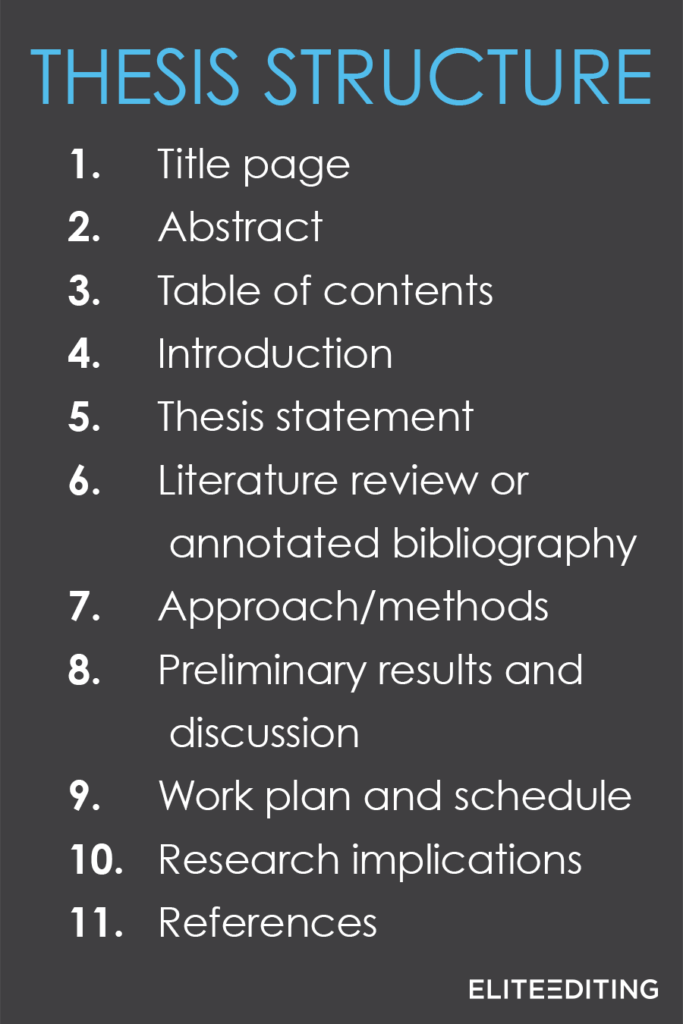
Let’s look at how to write a thesis proposal in greater detail.
Title Page and Creating a Title
The title of your project is likely to be a brief statement of your research topic, approach, and intent. It will be far easier to write a title once you’ve written a thesis statement (see below) because it is likely to restate or incorporate your thesis statement.
Violence and Redemption in Modern Afghani Literature: A Marxist Analysis of Power Structures in The Kite Runner and The Wasted Vigil
Living the Fantasy: Addiction and Social Identity in World of Warcraft
Your title page will include this title, your name, your department and institution, your adviser, your adviser’s institution, and the date you’re submitting the proposal.
Writing an Abstract
An abstract is a short summary of your full proposal, usually about a page in length. It hits the highlights of the proposal as a whole, including your title, your thesis statement, a quick summary of your plan of research, and a statement about why this project matters.
Table of Contents
If you’re writing your table of contents, you’re minutes away from a celebratory “Woo-hoo!” because you’re almost finished. A table of contents will list all the headings and subheadings of your proposal with lovely indentations and the correct page numbers. If you’re using MS Word, and you’ve been formatting your headings in the appropriate styles, you can automatically generate a table of contents that will make everything look very pretty indeed.
Writing the Thesis Statement
It’s not a simple question: How do you write a good thesis statement? Your thesis statement may well be the hardest sentence (or two—three at the most) you ever have to write. Despairing tears or frustrated anger are not out of the question. However, once you formulate that thesis statement, you will be off and running because now you have a beautifully clear and specific goal to head for.
A thesis statement should clearly define the scope and intent of your project. It might be a hypothesis or a question, or it might be a firm statement. The hours of work that will become your thesis will then prove (or possibly disprove, though hopefully in a deeply productive way) your thesis statement, so it should be something provable—something that can in some way be measured.
Let’s look at some examples of how to write a good thesis statement.
Not so good:
Taking a year off between high school and college is a good idea.
A “good idea” is vague and indefensible. Good by whose standards? How can you prove that?
Students who take a year off between high school and college are more academically successful than their peers.
This is better because it limits the scope of the project to academics, but it’s still rather vague and unwieldy. It also doesn’t suggest what metrics will be used to judge “academically successful.”
Better still:
Students who take a year off between high school and college are significantly more likely than their peers to graduate within four years with a B average or better.
This thesis statement works because it is concrete and measurable. The data you collect will either clearly prove the statement or disprove it.
How does the internet affect social behavior?
Wow, that’s a huge question. Also, there is nothing to prove, measure, or evaluate. It’s a topic rather than a thesis. It might be what you’re generally interested in, but you have yet to find the aspect of this topic that you can effectively research.
The internet has changed how American teens approach gender.
At least this is a statement, but it’s still too vague. “Changed” how? And what does “approach” mean?
The social media profiles of American teens thirteen to eighteen years old reflect this demographic’s increasing comfort with fluid sexual and gender identities.
This thesis statement could probably still be improved, but it is getting toward something measurable and provable.
Writing a Thesis Proposal Introduction
Your introduction will do just that—introduce your readers to your topic and thesis. Don’t mistake this for an introductory paragraph, however. This is where you’ll summarize your project in the hopes of intriguing and engaging the committee that will either approve your thesis project or send you back to the drawing board. Your writing should be as clear, straightforward, and free from jargon as possible. You’ll contextualize your project within the broader scope of the topic, perhaps exploring the papers, research, or work that led to your formulation of your thesis. You’ll explain why your project excites you. You’ll illustrate your competence to embark on this project. Basically, you’ll sell your proposal.
Literature Review or Annotated Bibliography
You might be able to quickly cover the most relevant literature in your proposal introduction, but if there are many articles or books relevant to your research, your thesis proposal might include an annotated bibliography or a literature review (which is slightly more informal and conversational in approach). Here is where you’d not only list the most influential and crucial texts that underpin your research but also explain why they matter—that is, how they fit into your project. This is a way to show that gap in the research that you will be filling with your thesis project.
Explain Your Proposed Methods or Approach
Most thesis projects demand original research of some kind, and for degrees in the sciences (including the social sciences), that research may very well take the form of an experiment or raw data collection. Here is where you should describe your proposed methodology. What materials will you use? How will you collect your data? How will you analyze the data once it’s collected? Are you taking a qualitative or quantitative approach? Why? Will you need outside funding (for travel or other costs), and how do you propose to acquire that funding? Do you need space and equipment to conduct your research?
Provide Preliminary Results
It may be that you have already been testing the viability of your thesis project with some preliminary research (which is not a bad idea). If so, here is where you should provide the results of that research and your tentative interpretation of those results. Clearly show how this work fits into your larger project—and how it proves that you’re heading down a productive road of inquiry.
Design a Work Plan
Even if your particular program or professor doesn’t require you to include a work plan in your thesis proposal, you should still make one. There’s nothing more likely than a schedule—with deadlines!—to keep you on track and get your thesis done on time.
This section should
- lay out your plan,
- list the various stages of your project,
- set deadlines for the completion of each stage, and
- detail any work you’ve already completed.
In addition, your work plan should take into account any challenges (personal, practical, or institutional) that may affect the completion of the study.
Discuss Research Implications
Here, you are striving to answer this question: Why does this project matter in this place and at this time? It’s actually a wonderful exercise in focusing your own thoughts and evaluating the worth of your proposed project. Are you remedying a misunderstanding that might affect how to treat a particular medical condition? Are you exploring the dynamics of a culture that is (socially or politically) especially relevant at the moment? Are you providing new insight into a classic work of literature or music that will reinvigorate teachers and academics? Your research might have implications for the entire world or it might be of interest only to other specialists in your subject, but that really doesn’t matter. The point is to figure out and clearly state how your research will enhance the sum total of knowledge.
Notes and Bibliography
All statements in this thesis proposal need to be supported with data, whether that data is derived from your own research or gleaned from a third party. Using whatever citation style is most appropriate to your field, you should give credit to all your sources, primary or secondary. Note that this is separate from your literature review in that you’re only going to cite the sources you’ve used in your proposal.
Thesis Proposal Defense / Thesis Proposal Presentation
Your college or university may require you to appear in person at a thesis proposal defense or to make a thesis proposal presentation. In both cases, however, you’ll be presenting your proposal to your thesis committee (and possibly others) and then potentially answering their questions about your project. While this might seem alarming, this event is actually an excellent opportunity to pick your committee’s brain about possible obstacles or objections you will need to overcome while working on your project. Better to know right now that they’d rather you took a quantitative approach than do all the work and then discover their preference. It will also help focus you since knowing something is one level of understanding it—but explaining it to someone else can take your understanding to a much deeper level.
You should now have a much deeper understanding of how to write a thesis proposal. A clear, thorough, well-thought-out thesis proposal allows you to see the entire shape of your project before you invest huge amounts of time and energy into research that might end up leading nowhere. Your thesis proposal sets the stage for the success of your project as a whole, and it should reflect and predict the quality you intend to produce in your final thesis. That’s why your thesis proposal presentation also matters. In addition, remember that proofreading counts. It’s extremely important to carefully review your finished proposal for spelling, grammar, and structural errors.
With your thesis proposal completed and approved, you’re well on your way to embarking on what might be the most important project of your life to date. We wish you all the best with your studies, and if you decide you want an editor to cast an expert eye over any part—large or small—of your project, we here at Elite are happy to help!
Want more? Check out this post on credible online sources and how to find them.
Other Resources You Might Like

Crafting Timeless Content

Mastering the Art of Persuasive White Papers

Writing Effective Press Releases in a Digital Age
Get elite updates straight to your inbox..
- Content Writing
- Marketing and Sales Enablement
- Program Management
- AI Implementation
Who We Help
- Thought Leaders
- Cybersecurity
- Health Care
- Full-Time Careers
- Freelance Opportunities
- Press and Awards
- Success Stories
- About Elite
In the News
- Elite Creative Makes the Inc. 5000 for the Third Year in a Row

Reference management. Clean and simple.
How to prepare an excellent thesis defense
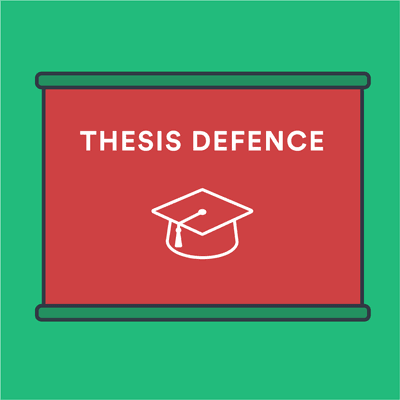
What is a thesis defense?
How long is a thesis defense, what happens at a thesis defense, your presentation, questions from the committee, 6 tips to help you prepare for your thesis defense, 1. anticipate questions and prepare for them, 2. dress for success, 3. ask for help, as needed, 4. have a backup plan, 5. prepare for the possibility that you might not know an answer, 6. de-stress before, during, and after, frequently asked questions about preparing an excellent thesis defense, related articles.
If you're about to complete, or have ever completed a graduate degree, you have most likely come across the term "thesis defense." In many countries, to finish a graduate degree, you have to write a thesis .
A thesis is a large paper, or multi-chapter work, based on a topic relating to your field of study.
Once you hand in your thesis, you will be assigned a date to defend your work. Your thesis defense meeting usually consists of you and a committee of two or more professors working in your program. It may also include other people, like professionals from other colleges or those who are working in your field.
During your thesis defense, you will be asked questions about your work. The main purpose of your thesis defense is for the committee to make sure that you actually understand your field and focus area.
The questions are usually open-ended and require the student to think critically about their work. By the time of your thesis defense, your paper has already been evaluated. The questions asked are not designed so that you actually have to aggressively "defend" your work; often, your thesis defense is more of a formality required so that you can get your degree.
- Check with your department about requirements and timing.
- Re-read your thesis.
- Anticipate questions and prepare for them.
- Create a back-up plan to deal with technology hiccups.
- Plan de-stressing activities both before, and after, your defense.
How long your oral thesis defense is depends largely on the institution and requirements of your degree. It is best to consult your department or institution about this. In general, a thesis defense may take only 20 minutes, but it may also take two hours or more. The length also depends on how much time is allocated to the presentation and questioning part.
Tip: Check with your department or institution as soon as possible to determine the approved length for a thesis defense.
First of all, be aware that a thesis defense varies from country to country. This is just a general overview, but a thesis defense can take many different formats. Some are closed, others are public defenses. Some take place with two committee members, some with more examiners.
The same goes for the length of your thesis defense, as mentioned above. The most important first step for you is to clarify with your department what the structure of your thesis defense will look like. In general, your thesis defense will include:
- your presentation of around 20-30 minutes
- questions from the committee
- questions from the audience (if the defense is public and the department allows it)
You might have to give a presentation, often with Powerpoint, Google slides, or Keynote slides. Make sure to prepare an appropriate amount of slides. A general rule is to use about 10 slides for a 20-minute presentation.
But that also depends on your specific topic and the way you present. The good news is that there will be plenty of time ahead of your thesis defense to prepare your slides and practice your presentation alone and in front of friends or family.
Tip: Practice delivering your thesis presentation in front of family, friends, or colleagues.
You can prepare your slides by using information from your thesis' first chapter (the overview of your thesis) as a framework or outline. Substantive information in your thesis should correspond with your slides.
Make sure your slides are of good quality— both in terms of the integrity of the information and the appearance. If you need more help with how to prepare your presentation slides, both the ASQ Higher Education Brief and James Hayton have good guidelines on the topic.
The committee will ask questions about your work after you finish your presentation. The questions will most likely be about the core content of your thesis, such as what you learned from the study you conducted. They may also ask you to summarize certain findings and to discuss how your work will contribute to the existing body of knowledge.
Tip: Read your entire thesis in preparation of the questions, so you have a refreshed perspective on your work.
While you are preparing, you can create a list of possible questions and try to answer them. You can foresee many of the questions you will get by simply spending some time rereading your thesis.
Here are a few tips on how to prepare for your thesis defense:
You can absolutely prepare for most of the questions you will be asked. Read through your thesis and while you're reading it, create a list of possible questions. In addition, since you will know who will be on the committee, look at the academic expertise of the committee members. In what areas would they most likely be focused?
If possible, sit at other thesis defenses with these committee members to get a feel for how they ask and what they ask. As a graduate student, you should generally be adept at anticipating test questions, so use this advantage to gather as much information as possible before your thesis defense meeting.
Your thesis defense is a formal event, often the entire department or university is invited to participate. It signals a critical rite of passage for graduate students and faculty who have supported them throughout a long and challenging process.
While most universities don't have specific rules on how to dress for that event, do regard it with dignity and respect. This one might be a no-brainer, but know that you should dress as if you were on a job interview or delivering a paper at a conference.
It might help you deal with your stress before your thesis defense to entrust someone with the smaller but important responsibilities of your defense well ahead of schedule. This trusted person could be responsible for:
- preparing the room of the day of defense
- setting up equipment for the presentation
- preparing and distributing handouts
Technology is unpredictable. Life is too. There are no guarantees that your Powerpoint presentation will work at all or look the way it is supposed to on the big screen. We've all been there. Make sure to have a plan B for these situations. Handouts can help when technology fails, and an additional clean shirt can save the day if you have a spill.
One of the scariest aspects of the defense is the possibility of being asked a question you can't answer. While you can prepare for some questions, you can never know exactly what the committee will ask.
There will always be gaps in your knowledge. But your thesis defense is not about being perfect and knowing everything, it's about how you deal with challenging situations. You are not expected to know everything.
James Hayton writes on his blog that examiners will sometimes even ask questions they don't know the answer to, out of curiosity, or because they want to see how you think. While it is ok sometimes to just say "I don't know", he advises to try something like "I don't know, but I would think [...] because of x and y, but you would need to do [...] in order to find out.” This shows that you have the ability to think as an academic.
You will be nervous. But your examiners will expect you to be nervous. Being well prepared can help minimize your stress, but do know that your examiners have seen this many times before and are willing to help, by repeating questions, for example. Dora Farkas at finishyourthesis.com notes that it’s a myth that thesis committees are out to get you.
Two common symptoms of being nervous are talking really fast and nervous laughs. Try to slow yourself down and take a deep breath. Remember what feels like hours to you are just a few seconds in real life.
- Try meditational breathing right before your defense.
- Get plenty of exercise and sleep in the weeks prior to your defense.
- Have your clothes or other items you need ready to go the night before.
- During your defense, allow yourself to process each question before answering.
- Go to dinner with friends and family, or to a fun activity like mini-golf, after your defense.
Allow yourself to process each question, respond to it, and stop talking once you have responded. While a smile can often help dissolve a difficult situation, remember that nervous laughs can be irritating for your audience.
We all make mistakes and your thesis defense will not be perfect. However, careful preparation, mindfulness, and confidence can help you feel less stressful both before, and during, your defense.
Finally, consider planning something fun that you can look forward to after your defense.
It is completely normal to be nervous. Being well prepared can help minimize your stress, but do know that your examiners have seen this many times before and are willing to help, by repeating questions for example if needed. Slow yourself down, and take a deep breath.
Your thesis defense is not about being perfect and knowing everything, it's about how you deal with challenging situations. James Hayton writes on his blog that it is ok sometimes to just say "I don't know", but he advises to try something like "I don't know, but I would think [...] because of x and y, you would need to do [...] in order to find out".
Your Powerpoint presentation can get stuck or not look the way it is supposed to do on the big screen. It can happen and your supervisors know it. In general, handouts can always save the day when technology fails.
- Dress for success.
- Ask for help setting up.
- Have a backup plan (in case technology fails you).
- Deal with your nerves.

Thesis Proposal
Thesis proposals.
Graduate students begin the thesis process by writing a thesis proposal that describes the central elements of the thesis work. Those elements vary depending on the type of thesis (research, artistic, or project) that the student plans to write. Students begin drafting the thesis proposal in the course Thesis Proposal Seminar .
Below, please find detailed information about the following:
- research thesis proposal
- artistic thesis proposal
- project thesis proposal
- formatting your proposal
- getting your proposal approved
- submit your proposal
Research Thesis Proposal
The proposal for a research thesis consists of five sections:
- Thesis Statement Following an optional introduction, the basic function of this section is to articulate a phenomenon that the student proposes to investigate (whether a social event, process, a literary work, an intellectual idea or something else), and the question(s), issue(s) or problem(s) related to that phenomenon that the student plans to address in the thesis. The core of the statement may take the form of a hypothesis that the student will test, of a proposition or argument that the student intends to support, or of a general problem or question the student will explore. The section puts that basic problem statement in a larger context by explaining its historical origins (where did it come from?) and its intellectual, social, and/or artistic context (what conversation, debate, or line of inquiry does it participate in?). It also describes the sub-questions or themes that constitute the general problem. Students will cite appropriate scholarly, professional and other sources for the ideas, questions and background information contained in the section.
- Research Methods In this section, the student will identify (a) the kinds of information that needed to answer the question(s) raised in the Thesis Statement, (b) the methods the student will use to gather that information, and (c) the strategies by which the student will organize and analyze the information in such a way as to reach and support a conclusion, to construct a sound argument. If the central problem has several facets, the student may need an array of different methods for collecting and analyzing information. Students should be as precise as possible in each stage of the methods statement: Is information needed about the stylistic techniques in a novel, about changes in the poverty rates in Kenya since independence, about the ways children think about nature? Will the student pull out the metaphors in a text, find government reports on household income, interview kids about their experiences in the woods? Will the student deploy statistical forms of content analysis, correlate poverty rates with political changes, interpret themes in children’s stories? Students should reflect on the broad methodological approaches that they propose to use, and cite sources from which they derive their methods and tools. A student's central goal is to demonstrate that they know how to go about answering the question(s) that have been raised. Please note that if students intend to conduct research on living people, they will need to get the approval of the University Committee on Activities Involving Human Subjects (UCAIHS). Before they apply for that approval, students will need to take a tutorial and pass a test on the various regulations. Refer to the UCAIHS website for more information.
- Justification and Limitations This section of the proposal should explain the rationale for the thesis and the importance of the topic. Indicate the reasons why this study is important to conduct and whom it will benefit. Identify the limits beyond which the inquiry will not go. For instance, if a student is writing about a historical subject, the student must explain the relevance of the time period selected. Finally, describe the contribution the work will make to the field.
- Conclusion This section should summarize the nature and intention of the student's work. Conclude the discussion and mention any pertinent information which may not have been included above.
- Annotated Bibliography This section consists of a list of books and articles and artworks with accompanying annotations that explain why these readings and other sources are likely to be crucial as the work advances.
back to top
Artistic Thesis Proposal
The artistic thesis consists of an artistic work and supporting essays, and it is important to conceive of each element as contributing to a coherent whole. The proposal itself consists of five sections:
- Concept Statement This section includes a brief introduction that forms the framework for the entire thesis and articulates the questions around which the creative project and supporting essays revolve.
- Description of the Artistic Work and Artistic Aims This section describes the major artistic work that will comprise the submitted artistic thesis. Students may want to refer to particular artistic influences or genres that will inform the work, or describe the aesthetic from which the creative work derives. In this section, students should also: refer to some of the artistic reasons that led to their decision to embark on this particular project; discuss the goals that will guide the development of the work; and provide concrete details about the final form and media of the work (will it be, for example, a collection of short stories, a novel; an evening of dance an exhibition of paintings, a film, or what?). If the artwork involves live performance, this section should state whether it will be a public or private event, where the event will be held, and any other details relevant to bringing the project to completion.
This section should provide the reader with relevant historical or critical information to place the central research question in context, and this section should also discuss the key theories, methods, and sources to be used within the research essay. It should demonstrate that the student knows how to begin answering the question(s) they are posing. What sorts of things will the student need to find out? What research methods will be used? What kinds of sources will be reviewed, and how will information from them be used? Who, if anyone, will be interviewed, and what kinds of questions will the subjects be asked? Students should also reflect, in this section, on the broad analytical approach that will structure their research and identify the school(s) of thought that will inform their investigations.
- Justification and Limitations This section should explain the importance of the student's work in the context of their particular artistic discipline and discuss how all components of the thesis project taken together as a single project will contribute to the scholarly and artistic fields with which it engages. This section should also discuss limitations, personal and practical, relating to the project and the student’s readiness. If the project is a film, for example, how much direct experience has the student already had in that field, and how will the student allocate the time to finish the project by the desired defense date? How much is the project likely to cost, and how does the student expect to obtain funding? What kind of spaces will be needed for rehearsal as well as presentation of the work?
Project Thesis Proposal
The project thesis includes two major components: (a) an activity (program, intervention, campaign, etc.) designed to address (solve, remediate, improve) a problem, issue or opportunity in the student's domain as a professional or activist; and (b) a written document that describes, rationalizes, analyzes, and assesses the activity. It is not strictly a research study, but rather an exercise in reflective practice. Therefore, the proposal takes a form different from that of the research or artistic thesis proposal. Please note, as well, that a project thesis must be not only designed but implemented and evaluated.
- Problem Statement This section of the proposal identifies, describes, and analyzes the problem (issue, need, opportunity) that the student will address in the project. Clearly articulate the nature of the problem: its historical, social and professional context; its dimensions and extent; its impact, and perhaps some previous efforts to address it. Present information that explains the student's understanding of the origins or causes of the problem, to set up the rationale for the choice of a strategy to solve it. At each stage, refer to appropriate scholarly and professional literatures.
- Project Plan Students should spell out their plans for addressing the problem. Students should describe the institutional setting within which the project will take place, as well as the individuals, groups, or organizations with whom they will work. What will the student (and, perhaps, others) do? What resources and strategies will be used? If the student need funds, how will they be raised and disbursed? What schedule will be followed? Be efficient, but concrete and clear in specifying the activities that will make up the project. Identify the professional and theoretical sources of the strategies for the project: What precedents and ideas are the student drawing on? Also, the student should discuss the means by which they will record and report the project activities for the members of the thesis committee. Will the student write a journal, shoot videos, keep material artifacts and documents? Students must be clear about how they intend to document the project. They may also elect to invite the members of their committee to witness the project first-hand.
- Assessment The proposal speaks to three aspects of the assessment process. In all three, students should be concrete and refer to appropriate literatures as sources of their plans. Criteria : First, students should describe and justify the criteria by which they will determine whether the project has succeeded. What are the goals and objectives? What changes does the student want to see in the participants, the organization, the larger world? Methods: What information will be needed to determine whether the goals and objectives have been met? How will that information be collected and organized? Analysis : How will that information be utilized to describe the project’s success or failure? What sorts of lessons does the student hope to draw from the assessment?
- Justification and Limitations This section of the proposal should explain the rationale for the thesis and the importance of the topic. Indicate the reasons why this study is important to conduct and whom it will benefit. Identify the limits beyond which the inquiry will not go. Finally, describe the contribution the work will make to the field.
- Conclusion This section should summarize the nature and intention of the work. Conclude the discussion and mention any pertinent information which may not have been included above.
Format of the Proposal
All thesis proposals should conform to the following specifications:
- Title Page The title should be reasonably succinct, but descriptive enough to convey the nature of the thesis; the title page should include your full name, the date of submission, and your adviser’s name.
- Length The thesis proposal should be approximately 8 pages, excluding the annotated bibliography. Remember that this is a proposal, not the thesis itself; tell us what you propose to do and how, don’t do it.
- Annotated Bibliography This bibliography should contain brief commentaries on no fewer than 10–15 relevant source works.
The Approval Process for the Thesis Proposal
The Thesis Proposal Seminar (TPS) Students write their thesis proposals while enrolled in the Thesis Proposal Seminar (CORE-GG 2401, a 2-credit core requirement offered every spring). Throughout that semester, students work closely with their Adviser and Instructor to draft an acceptable proposal. When the proposal has received approval from both the Thesis Proposal Seminar instructor (Gallatin reviewer) and the adviser, the student is allowed to move on to their thesis research. The three steps of the approval process are outlined below.
- TPS Instructor/Reviewer Approval The Thesis Proposal Seminar instructor serves as the Gallatin reviewer of the thesis proposal. A student must receive a grade of ‘Pass’ in the Thesis Proposal Seminar for the proposal to be considered ‘reviewer approved.’ If the student’s proposal is not finished at the end of the semester, the student will receive a grade of 'Incomplete' in the course and will have until June 15th to submit the proposal before moving on to thesis research.
- Adviser Approval Students work closely with their advisers over the course of the semester to produce a proposal that the adviser can approve. Once the adviser agrees that the proposal is ready, students submit their final proposal via the online Thesis Proposal submission form . The Thesis Proposal submission form allows students to provide Gallatin with additional information about the courses, internships, independent studies, jobs, and other experiences that have prepared the student for their thesis work.
- MA Program Approval Once the M.A. Program verifies adviser approval of the proposal and the student has passed the TPS, the MA Program updates the student record to show that the Thesis Proposal requirement has been satisfied.
The deadline for submitting an adviser approved thesis proposal online is June 15.
How to write a thesis proposal
I. Framework II. Structure of a thesis proposal III. Order in which to write the proposal IV. Tips V. Resources
I. Framework
- An environmental issue is identified.
- Other people's work on the topic is collected and evaluated.
- Data necessary to solving the problem are either collected by the student, or obtained independently.
- Data are analyzed using techniques appropriate to the data set.
- Results of the analysis are reported and are interpreted in light of the initial environmental issue.
- the thesis topic addresses a significant environmental problem;
- an organized plan is in place for collecting or obtaining data to help solve the problem;
- methods of data analysis have been identified and are appropriate to the data set.
II. Structure of a thesis proposal
- Table of contents
- Introduction
- Thesis statement
- Approach/methods
- Preliminary results and discussion
- Work plan including time table
- Implications of research
- List of references
- contains short, descriptive title of the proposed thesis project (should be fairly self-explanatory)
- and author, institution, department, resreach mentor, mentor's institution, and date of delivery
- the abstract is a brief summary of your thesis proposal
- its length should not exceed ~200 words
- present a brief introduction to the issue
- make the key statement of your thesis
- give a summary of how you want to address the issue
- include a possible implication of your work, if successfully completed
- list all headings and subheadings with page numbers
- indent subheadings
- this section sets the context for your proposed project and must capture the reader's interest
- explain the background of your study starting from a broad picture narrowing in on your research question
- review what is known about your research topic as far as it is relevant to your thesis
- cite relevant references
- the introduction should be at a level that makes it easy to understand for readers with a general science background, for example your classmates
- in a couple of sentences, state your thesis
- this statement can take the form of a hypothesis, research question, project statement, or goal statement
- the thesis statement should capture the essence of your intended project and also help to put boundaries around it
- this section contains an overall description of your approach, materials, and procedures
- what methods will be used?
- how will data be collected and analyzed?
- what materials will be used?
- include calculations, technique, procedure, equipment, and calibration graphs
- detail limitations, assumptions, and range of validity
- citations should be limited to data sources and more complete descriptions of procedures
- do not include results and discussion of results here
- present any results you already have obtained
- discuss how they fit in the framework of your thesis
- describe in detail what you plan to do until completion of your senior thesis project
- list the stages of your project in a table format
- indicate deadlines you have set for completing each stage of the project, including any work you have already completed
- discuss any particular challenges that need to be overcome
- what new knowledge will the proposed project produce that we do not already know?
- why is it worth knowing, what are the major implications?
- cite all ideas, concepts, text, data that are not your own
- if you make a statement, back it up with your own data or a reference
- all references cited in the text must be listed
- cite single-author references by the surname of the author (followed by date of the publication in parenthesis)
- ... according to Hays (1994)
- ... population growth is one of the greatest environmental concerns facing future generations (Hays, 1994).
- cite double-author references by the surnames of both authors (followed by date of the publication in parenthesis)
- e.g. Simpson and Hays (1994)
- cite more than double-author references by the surname of the first author followed by et al. and then the date of the publication
- e.g. Pfirman, Simpson and Hays would be:
- Pfirman et al. (1994)
- cite newspaper articles using the newspaper name and date, e.g.
- ....this problem was also recently discussed in the press (New York Times, 1/15/00)
- do not use footnotes
- list all references cited in the text in alphabetical order using the following format for different types of material:
- Hunt, S. (1966) Carbohydrate and amino acid composition of the egg capsules of the whelk. Nature , 210, 436-437.
- National Oceanic and Atmospheric Administration (1997) Commonly asked questions about ozone. http://www.noaa.gov/public-affairs/grounders/ozo1.html, 9/27/97.
- Pfirman, S.L., M. Stute, H.J. Simpson, and J. Hays (1996) Undergraduate research at Barnard and Columbia, Journal of Research , 11, 213-214.
- Pechenik, J.A. (1987) A short guide to writing about biology. Harper Collins Publishers, New York, 194pp.
- Pitelka, D.R., and F.M. Child (1964) Review of ciliary structure and function. In: Biochemistry and Physiology of Protozoa , Vol. 3 (S.H. Hutner, editor), Academic Press, New York, 131-198.
- Sambrotto, R. (1997) lecture notes, Environmental Data Analysis, Barnard College, Oct 2, 1997.
- Stute, M., J.F. Clark, P. Schlosser, W.S. Broecker, and G. Bonani (1995) A high altitude continental paleotemperature record derived from noble gases dissolved in groundwater from the San Juan Basin, New Mexico. Quat. Res. , 43, 209-220.
- New York Times (1/15/00) PCBs in the Hudson still an issue, A2.
- it is acceptable to put the initials of the individual authors behind their last names, e.g. Pfirman, S.L., Stute, M., Simpson, H.J., and Hays, J (1996) Undergraduate research at ......
III. Order in which to write the proposal
- Make an outline of your thesis proposal before you start writing
- Prepare figures and tables
- Figure captions
- Discussion of your data
- Inferences from your data
- Bibliography
- "Pictures say more than a thousand words!" Figures serve to illustrate important aspects of the background material, sample data, and analysis techniques.
- A well chosen and well labeled figure can reduce text length, and improve proposal clarity. Proposals often contain figures from other articles. These can be appropriate, but you should consider modifying them if the modifications will improve your point.
- The whole process of making a drawing is important for two reasons. First, it clarifies your thinking. If you dont understand the process, you cant draw it. Second, good drawings are very valuable. Other scientists will understand your paper better if you can make a drawing of your ideas. A co-author of mine has advised me: make figures that other people will want to steal. They will cite your paper because they want to use your figure in their paper.
- Make cartoons using a scientific drawing program. Depending upon the subject of your paper, a cartoon might incorporate the following:
- a picture of the scientific equipment that you are using and an explanation of how it works;
- a drawing of a cycle showing steps, feedback loops, and bifurcations: this can include chemical or mathematical equations;
- a flow chart showing the steps in a process and the possible causes and consequences.
- Incorporate graphs in the text or on separated sheets inserted in the thesis proposal
- Modern computer technology such as scanners and drafting programs are available in the department to help you create or modify pictures.
Grammar/spelling
- Poor grammar and spelling distract from the content of the proposal. The reader focuses on the grammar and spelling problems and misses keys points made in the text. Modern word processing programs have grammar and spell checkers. Use them.
- Read your proposal aloud - then have a friend read it aloud. If your sentences seem too long, make two or three sentences instead of one. Try to write the same way that you speak when you are explaining a concept. Most people speak more clearly than they write.
- You should have read your proposal over at least 5 times before handing it in
- Simple wording is generally better
- If you get comments from others that seem completely irrelevant to you, your paper is not written clearly enough never use a complex word if a simpler word will do
V. Resources/Acknowlegements
The senior seminar website has a very detailed document on " How to write a thesis " which you might want to look at. Most of the tips given there are relevant for your thesis proposal as well. Recommended books on scientific writing Some of the material on this page was adapted from: http://www.geo.utep.edu/Grad_Info/prop_guide.html http://www.hartwick.edu/anthropology/proposal.htm http://csdl.ics.hawaii.edu/FAQ/FAQ/thesis-proposal.html http://www.butler.edu/honors/PropsTheses.html

Researched by Consultants from Top-Tier Management Companies

Powerpoint Templates
Icon Bundle
Kpi Dashboard
Professional
Business Plans
Swot Analysis
Gantt Chart
Business Proposal
Marketing Plan
Project Management
Business Case
Business Model
Cyber Security
Business PPT
Digital Marketing
Digital Transformation
Human Resources
Product Management
Artificial Intelligence
Company Profile
Acknowledgement PPT
PPT Presentation
Reports Brochures
One Page Pitch
Interview PPT
All Categories
Top 15 Thesis Proposal Templates with Samples and Examples

Siranjeev Santhanam
Writing a thesis proposal requires a fusion of critical thinking and clear communication skills. A well-crafted thesis proposal would be able to capture the attention of the reader and make an otherwise dull and mundane topic appear interesting and exciting.
A thesis proposal is a document that underlines the research objectives, methods, and overarching significance of a proposed research project. It is usually written within the context of academic learning, by students seeking to pursue higher degree professional qualification. A thesis proposal tends operates as an overarching plan for the research, and an efficient means to convince the supervisors in the academy of the worthiness of the research subject in question.
Are you struggling to manage time when drafting your thesis document? We’ve got you covered. Click right here to check out other blog discussing top ten thesis timeline templates with samples and examples.
To many in the academic discipline, writing a thesis proposal can appear daunting, even overwhelming. Despite this, it constitutes an essential step in the academic process and in the broader systems of learning within all fields of science. It forces a student to think critically and unbiasedly about his or her research subject, to apply stringent methodologies within the framing of the research and to develop sound research standards to achieve the end goals in sight.
In our blog, we're going to be looking at some best thesis presentation ppt templates, made with the specific interests of the those in academic disciplines. These templates are 100% editable and customizable, giving users both structures, a starting point, and the capability to tailor the presentation to audience profile.
Looking to dive deeper into this subject? Click right here to check out other blog on research proposal templates that can give you the tools needed to get funded.
Let’s explore.
Template 1 Thesis Research Paper Proposal PowerPoint Presentation Slides
Users will find this PPT Template to be of great help in organizing their thesis material along the lines of what is needed to clear any panel from a reputed college or university. After introducing the study, outline an overview, research, and question/hypothesis in the problem statement. Then, this presentation template gives the user the best format for literature review, research method overview, research constraints, and references/bibliography slides to ensure the research effort gets all its due.
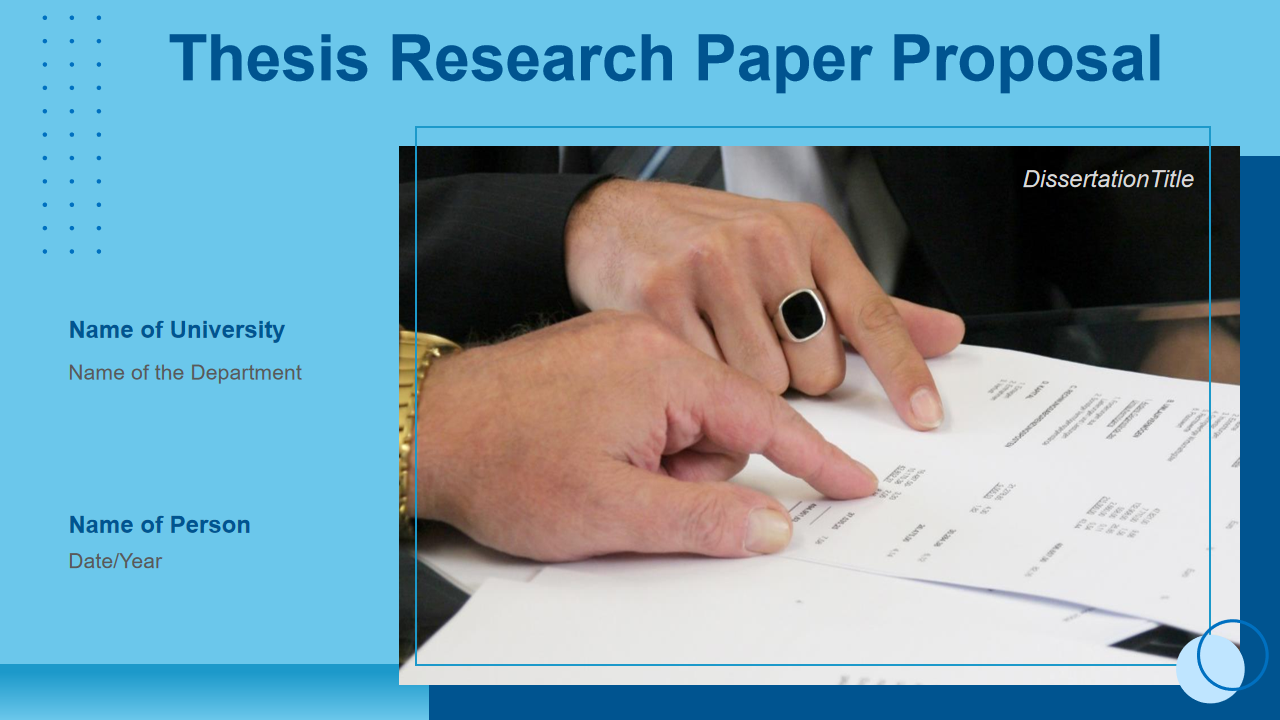
Download now!
Template 2 Planning Thesis Proposal PowerPoint Presentation Slides
This PPT Template starts with an abstract that lists the purpose, design methodology, findings, and the originality value of the thesis proposal. The methods or approach slide lists the five tools used as the basics of the research, which may be surveys, questionnaires, interviews, case studies, and observations. There are slides on the implications of the research, a work plan on a timetable, and a list of references/bibliographies included.

Template 3 Sample Thesis Proposal Template Presentation Slides
The thesis statement is a USP of this PPT Template, as is the design. The slide on preliminary results and discussions gives the researcher at least eight points to list and make his/her point. The work plan, including the table and the research implications, gives you the comprehensive license to put forward your thesis proposal.

Template 4 Abstract for Thesis Research Proposal PPT Template
The abstract is the segment of the presentation where you get to condense the main idea, methods, objectives, and expected outcomes of your research project. Utilizing this concise overview for your proposal can assist you in getting the attention you need from potential funders, supervisors or academic collaborators. Use slide to organize your research processes in a logical and coherent way. Underscore your originality, ingenuity and relevance of your research project with a download of this slide.
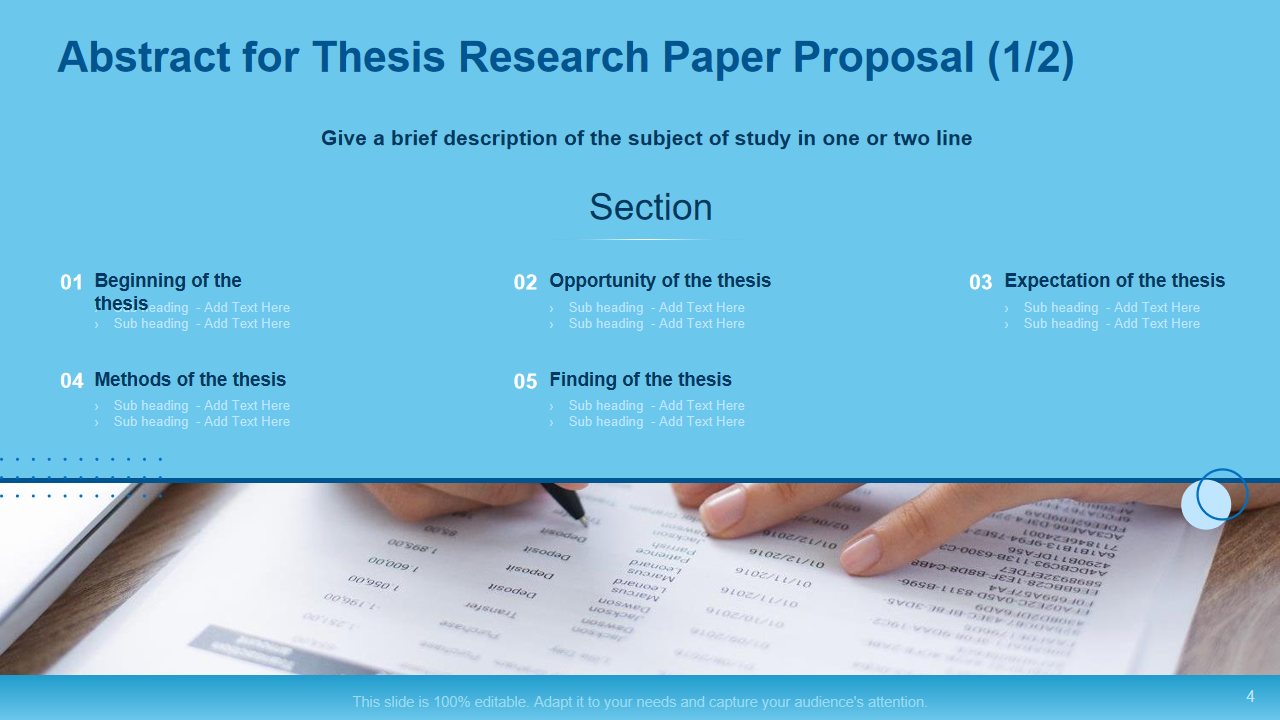
Download now
Template 5 Introduction of study for thesis research paper PPT Presentation
If you’re seeking professional and effective way to communicate the foundational elements of your research proposal, this slide is for you. The introduction of study section allows you to easily summarize and hone into the specific topic and domain of the thesis while convince potential audiences of the intrinsic value and significance of the project. It can also assist you in designing a more feasible and impactful thesis paper that has been structured with the appropriate levels of focus and feedback.

Template 6 Problem statement – Overview for thesis research paper proposal Presentation
The problem statement segment of the proposal is intended to isolate and identify the specific problem or gap that your research project seeks to address. It is a critical part of the overarching proposal and can be a central tenet in establishing the feasibility of your research project, and dictating the importance of the project in general. Use this template to help you formulate a clear and focused problem statement that can facilitate your research process and help you hone into the appropriate questions.
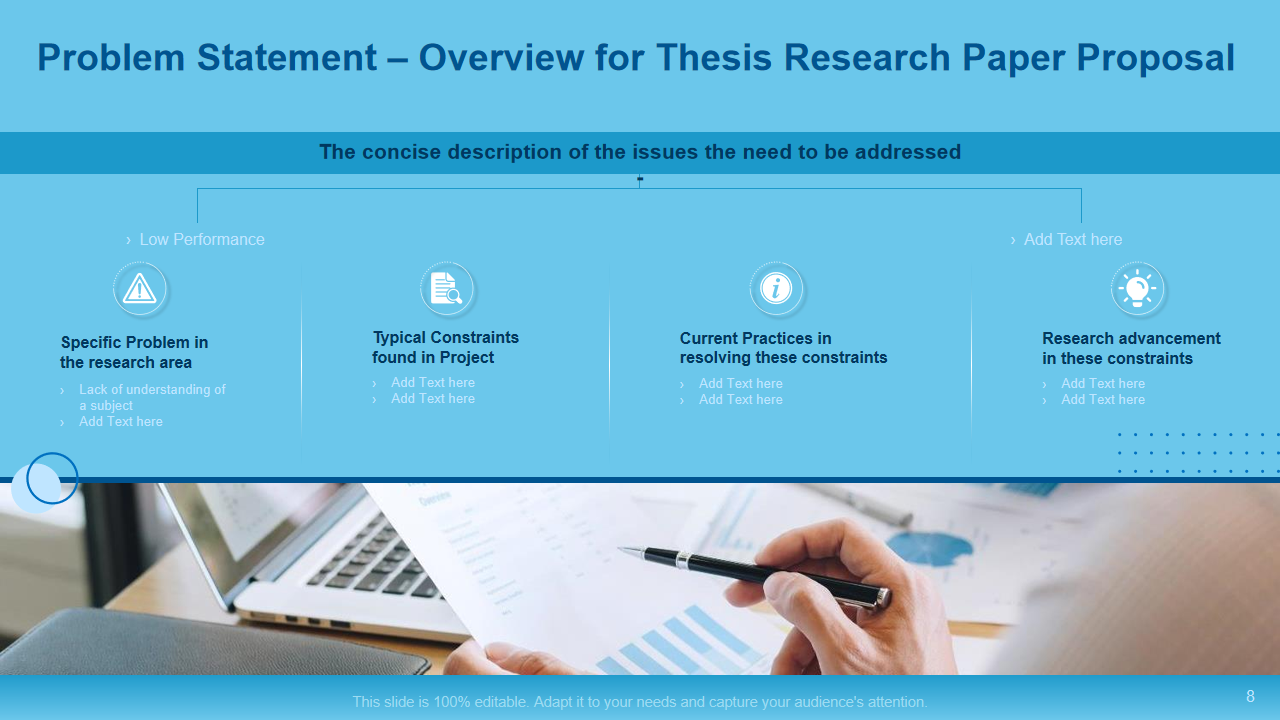
Template 7 Research Question/Hypothesis For Thesis Research Proposal
If you’re seeking to create a valid and sound research question for your thesis research paper proposal, this PPT Template can help facilitate the process. The ‘research question/hypothesis’ segment of the thesis research paper proposal exists to test the primary assumptions that your project seeks to probe. It is an important ingredient in the presentation, helping you in determining the right scale and scope of the project. Flesh out the right research question to direct the broader research structure and the data collection process with this template. Demonstrate your innate analytical skills while authenticating your research goals using this PPT Slide.
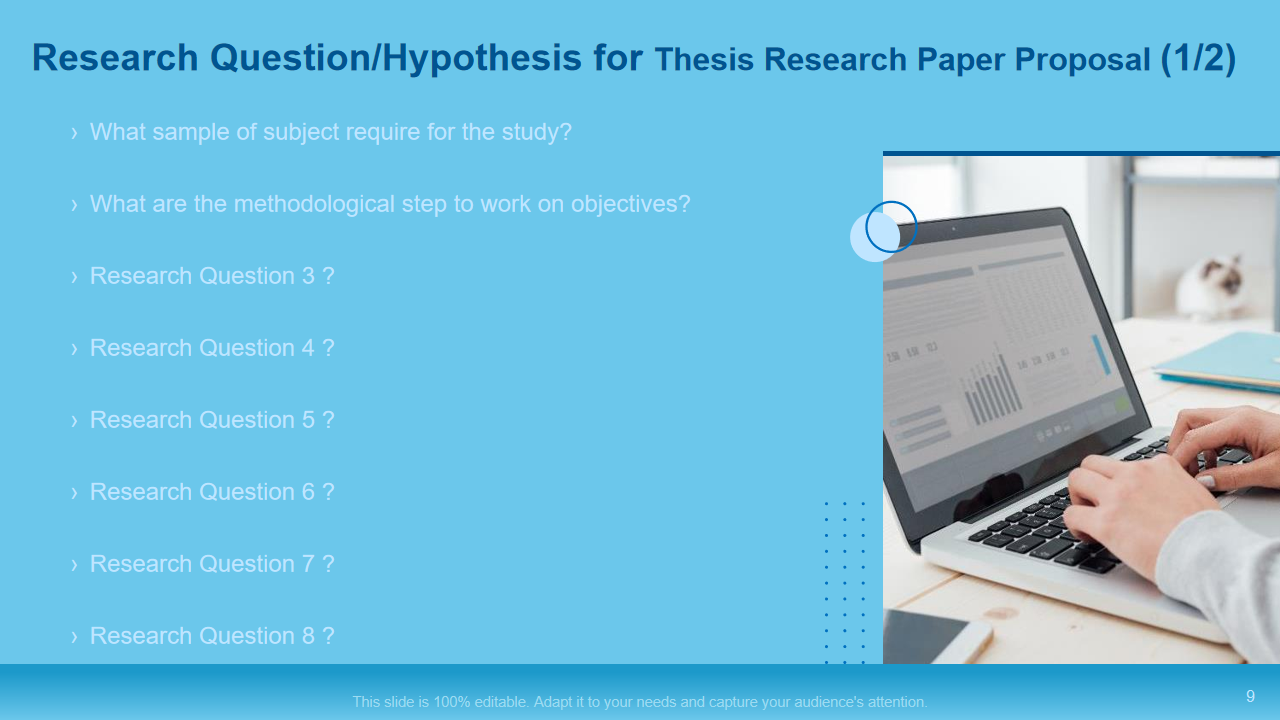
Template 8 Key assertions/objectives for thesis research proposal PPT Template
Use this slide as an effective instrument in creating a sound and credible presentation, impressing your audience, and making a difference in your own research experience. This segment of the presentation is meant to underscore the central claims or goals that your research project seeks to achieve. It is also a key component in the broader research proposal that can give you the tools to customize the scope and limitations of the project.
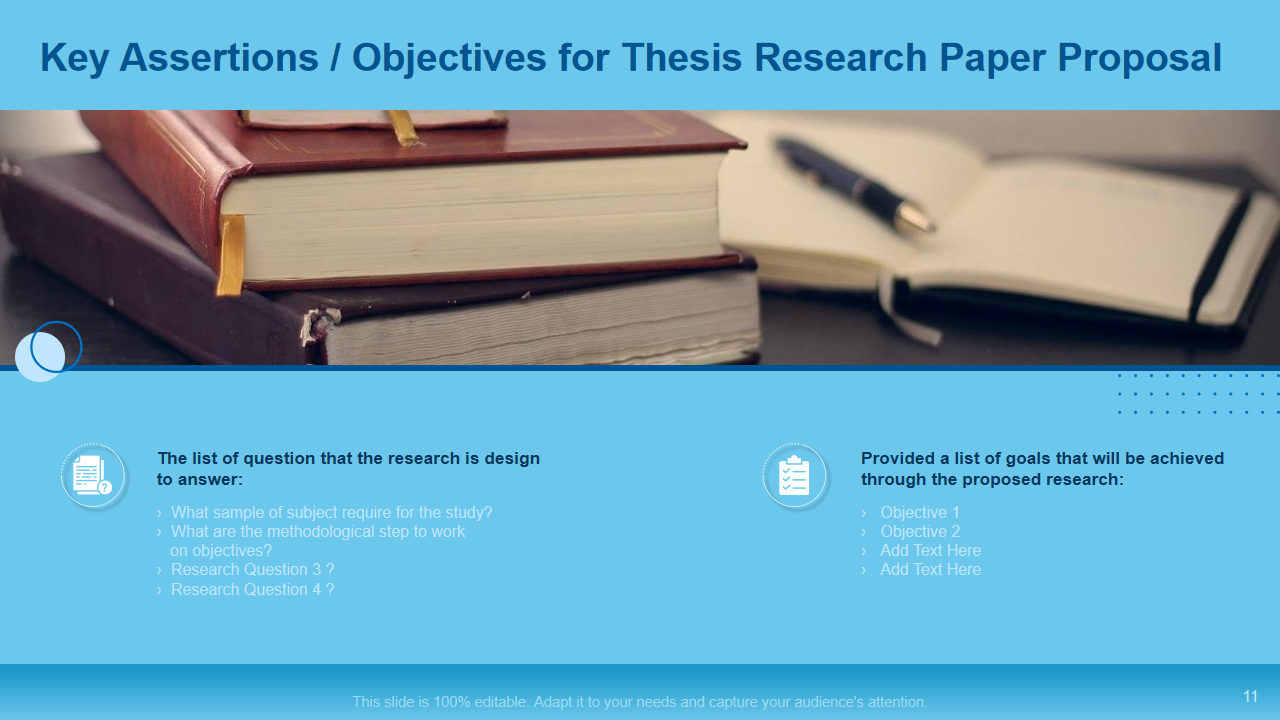
Template 9 Thesis Statement of Planning Thesis Proposal PPT
A strong thesis statement can help you in summarizing the central features of the research project, organizing the process around the most vital aspects. It is a crucial element of the proposal and can help to grant clarity and focus to the process, while also proving the originality and significance. Download this slide now and acquire the means to make powerful and persuasive arguments that help to take your overall thesis approach to the next level.
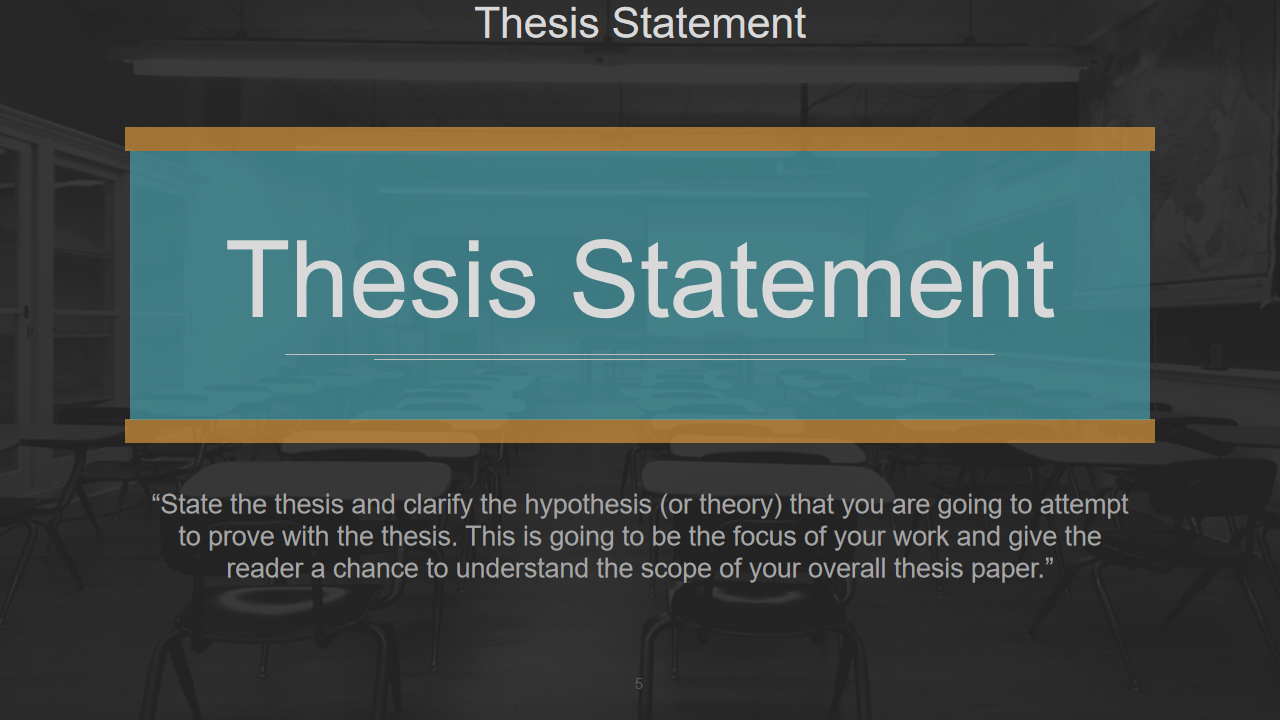
Template 10 Methods or Approach Planning Thesis Proposal
This slide on methods or approach can help you consolidate your research design, while also presenting the data collection techniques and the expected outcomes of the project to your audiences. Incorporate this your overall research proposal to prove your expertise with a demonstration of the systematic and rigorous procedures that help to direct the research.
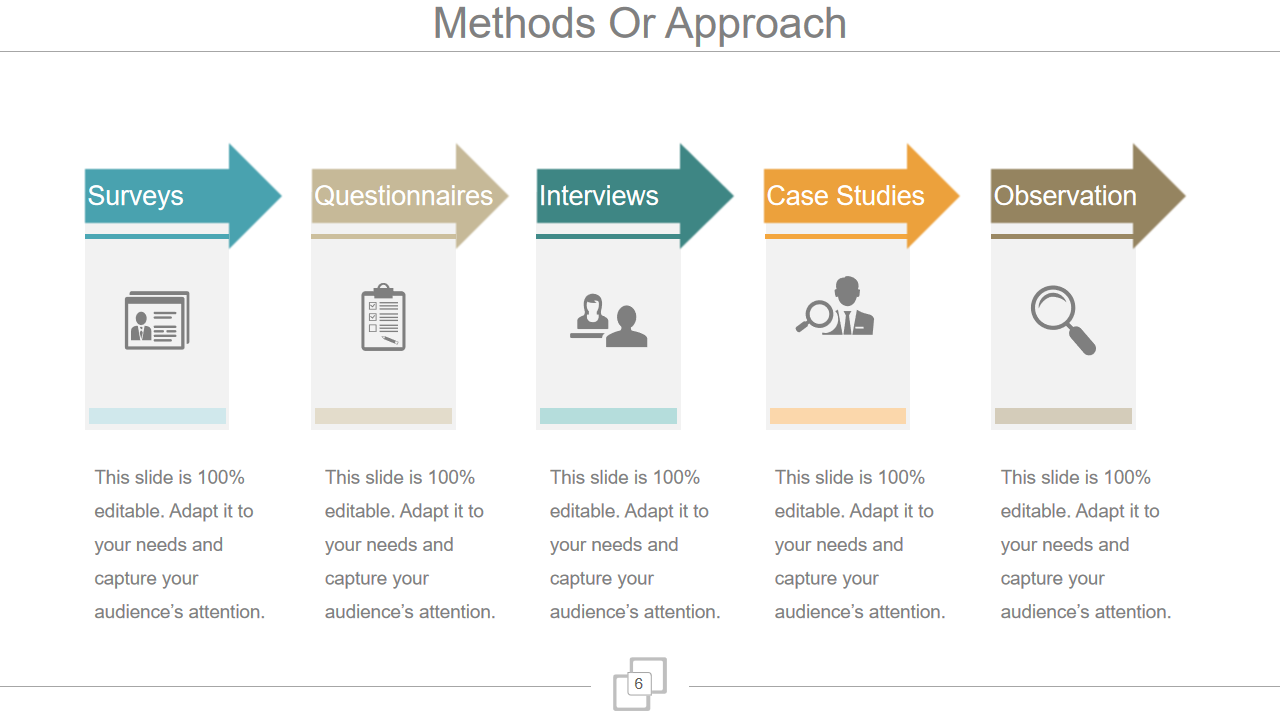
Template 11 Preliminary discussions and results PPT Thesis Proposal
The segment of the presentation titled, preliminary discussions and results, can help you in showcasing the essential findings and the broader implications of the project. Integrate this slide into your thesis procedures to create a better understanding of your own research merits and to underscore the value that your thesis holds within the credible field of study. The slide can be a useful asset for any research domain that rests on systematic and rigorous analytical processes. Download this slide and communicate your challenges, solutions, and present your findings to finetune the remainder of the project.
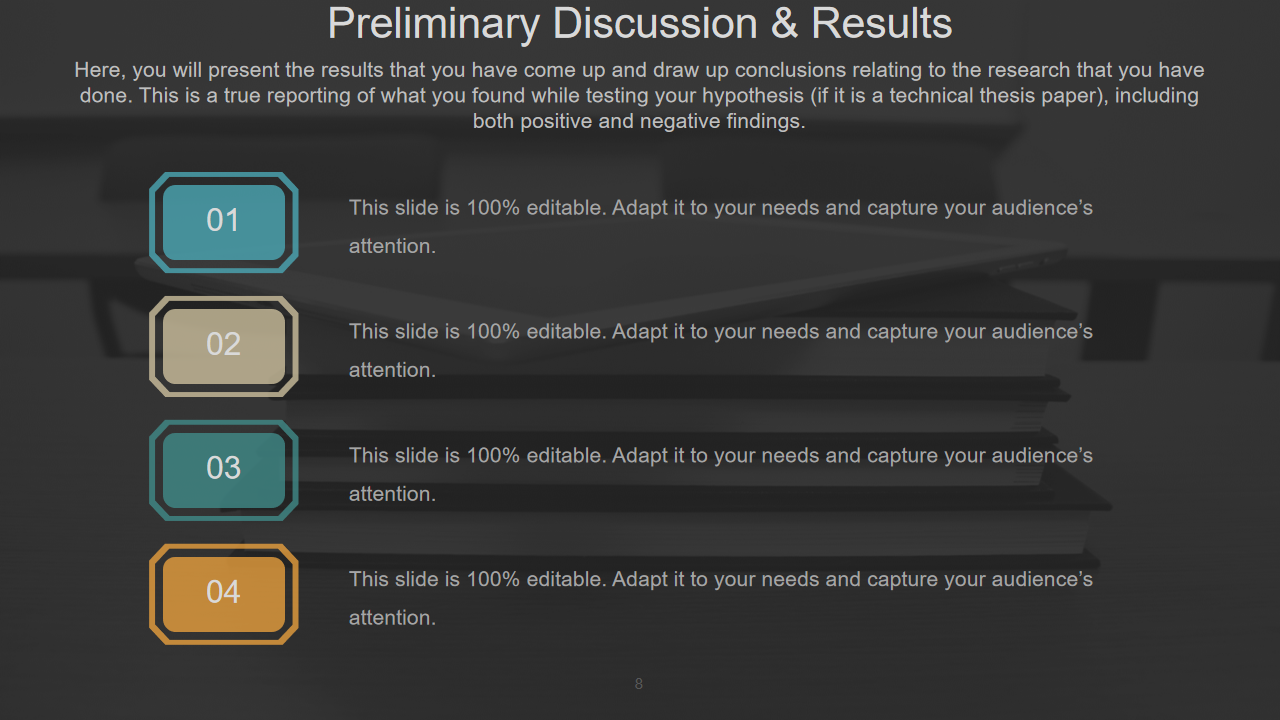
Template 12 Work plan with timetable PPT Thesis Proposal
If you’re struggling to create a more efficient and structured work process, then we’ve got just the template you need. The work table has been segmented into two major sections, titled, activities and month, and comes with some pre-designed highlights that you can use such as the development of research tools, data collection, data entry and analysis, validation of equipment, training of enumerators and more.
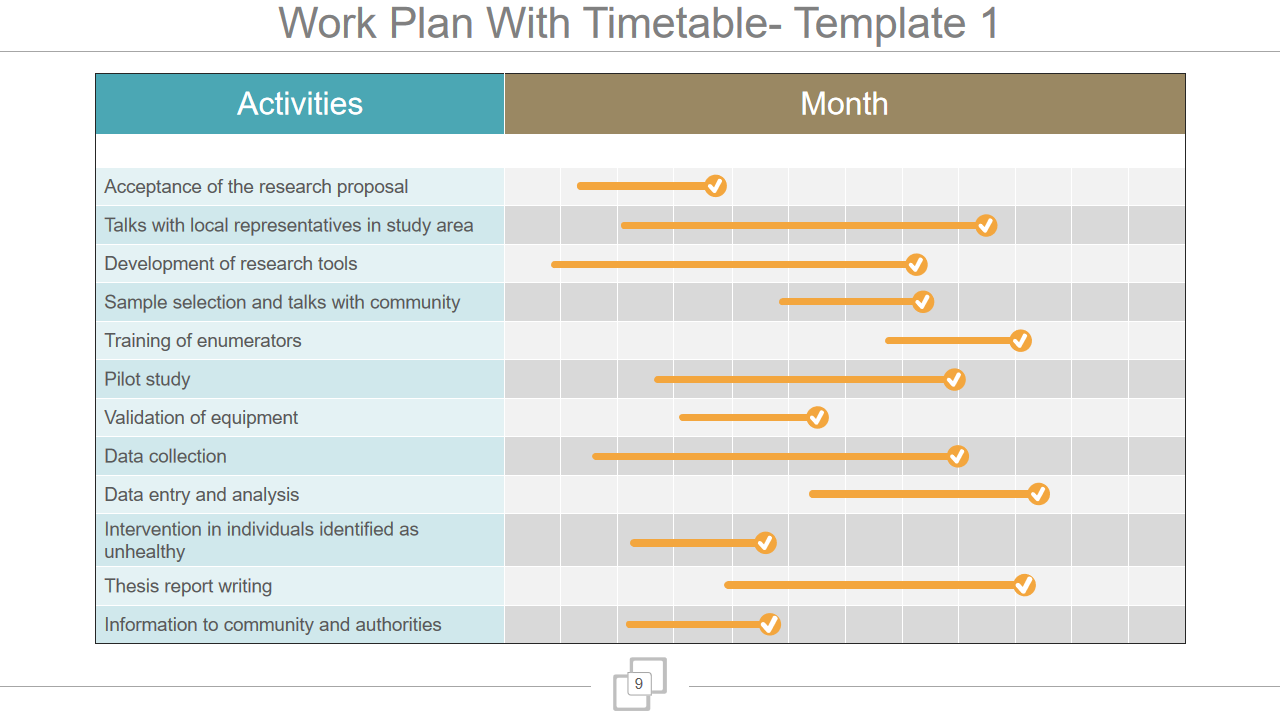
Template 13 Implication of research Thesis Proposal PPT
The Implication of Research section in your thesis proposal, helps you project the significance and the impact of the project at hand, thereby creating the right conditions to get the relevant stakeholders on your side for the project. Tailor this slide to your own needs and create the right message to employ the mechanics of your academy, broadcasting the vision and the intrinsic value of your research.
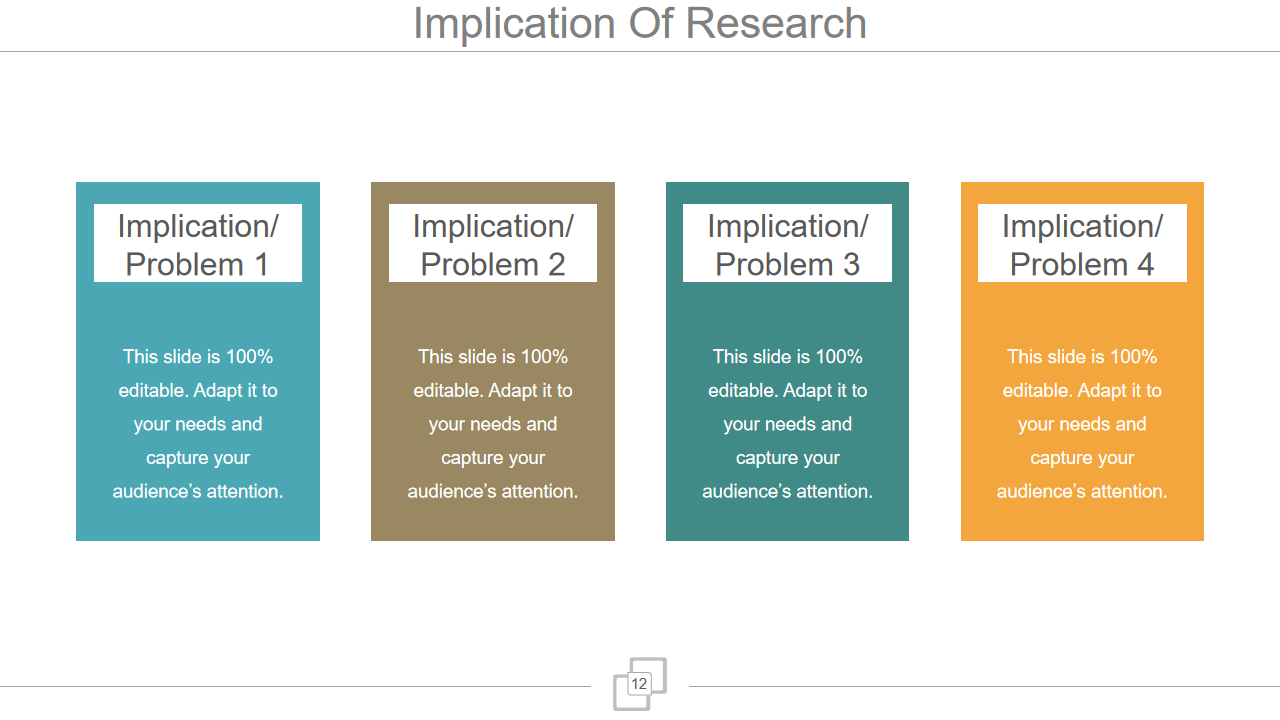
Template 14 Timeline Thesis Proposal Template Sample
Use this template to streamline your research activities and engage with the working process, thereby creating a more robust and intensive thesis proposal. The timeline comes with visual cues that separate the years. The graph can be further customized to your own convenience, giving you the liberty to add or subtract content from it as you see fit.

Template 15 30-60-90 Day Plan Timeline Thesis Proposal Template Sample
This slide allows you to add manageable milestones tied to the research thesis, allowing you to optimize your work output and productivity. Use this slide to bring on a more focused and result-driven work procedure, achieving and exceeding the set targets and calibrating the right mechanisms to bring your thesis the credit that it needs.

BE SURE-FOOTED, BE PREPARED
Our templates have been designed to create a unique user experience within corporate and non-corporate environments, pairing strong visuals with pre-designed well-researched content. With these above templates, you are given the option of picking and choosing the material you deem appropriate and leaving out that which you don’t. Download our templates and apply them to the academic fray when drafting a thesis document.
Get ahead of the statistical hurdles that come along with research with the help of our pre-designed templates. Click here to check out other blog discussing top 10 statistical analysis research proposal templates now.
Related posts:
- Top 10 Idea Proposal Templates With Samples And Examples
- Top 10 Technology Proposal Templates with Examples and Samples
- Top 10 VoIP Proposal Templates with Samples and Examples
- Top 7 One-Page Research Proposal Templates with Examples and Samples
Liked this blog? Please recommend us

Top 10 4-Quadrant Chart Templates with Samples and Examples

Top 10 Sales Proposal Templates with Samples and Examples
This form is protected by reCAPTCHA - the Google Privacy Policy and Terms of Service apply.

Digital revolution powerpoint presentation slides

Sales funnel results presentation layouts
3d men joinning circular jigsaw puzzles ppt graphics icons

Business Strategic Planning Template For Organizations Powerpoint Presentation Slides

Future plan powerpoint template slide

Project Management Team Powerpoint Presentation Slides

Brand marketing powerpoint presentation slides

Launching a new service powerpoint presentation with slides go to market

Agenda powerpoint slide show

Four key metrics donut chart with percentage

Engineering and technology ppt inspiration example introduction continuous process improvement

Meet our team representing in circular format

- Thunder Bay •
- Faculty & Staff

- Romeo Research
- myCourseLink
- Other Programs & Studies
- Lakehead University and Confederation College - Joint Admissions
- Life After Lakehead: Careers
- Romeo Research Portal
- University Policies and Procedures
- 2023 SESBASS Symposium
- Biotechnology Applicants
- Biotechnology Courses
- Biotechnology Faculty Members
- Biotechnology PhD Potential Supervisors
- Biotechnology PhD Program Regulations
- Biotechnology PhD Program Requirements
- Biotechnology Supervisory Policy
- First Year - Comprehensive Exam
- First Year - Thesis Proposal Presentation
- SES International Student Events
- SES Social Events
- Student Employment and Opportunities
- Students - Completed
- Students - Current
- Symposiums - 2018 SESBASS
- Symposiums - 2019 HITBASS
- Symposiums - 2021 SESBASS
- Graduate Program
- Funding Available
- Potential Supervisors
- Forms and Due Dates
- News & Events

Thunder Bay
Phone: +1 (807) 343-8042
Thesis Proposal Presentation
Approval of your dissertation proposal by the supervisory committee.
The format of the Dissertation Proposal will be decided by the Supervisory Committee. The student must present the proposal in a public seminar, but may also be required to provide the committee with a written proposal. All members of the committee must approve the proposal as indicated by signing the Thesis Proposal Approval form. Students may be requested to revise the proposal based on committee input.
Format for your Thesis Proposal Presentation
Your Thesis Proposal Presentation should indicate that you have investigated the literature in your area and show that your research is novel. It should be clear that your experimental design and chosen methods are the most suitable for your work. We recommend you include the following in your proposal presentation:
- Introduction/Motivation
- Relevance to the Field and Originality Statement- what is new about your work that no one has done before
- Research Question- What are the main objectives of your research? Your thesis should have at least three chapters, and it should be clear to the committee what your three chapters will be.
- Research Strategy- Experimental Design
- Research Methods and Tools
- Expected Outcomes
- Timelines and Milestones- Indicate which years you expect to do each part of the research. What journal articles do you expect to publish and when.
- Plan B- What if the experiments you plan do not give good results? Do you anticipate any difficulties? How will you respond?
You may also wish to include any preliminary results you have obtained and any anticipated difficulties and how you plan on dealing with them.
Supervisory Committee Members
As part of your duties, you are being asked to evaluate the research proposal for the PhD candidate. As a supervisory committee member, you can advise the candidate on how their thesis proposal may be improved to meet the following requirements. To be approved, a research proposal should meet the following requirements:
- Contribution to knowledge: the research proposed is expected to contribute substantially to knowledge in the field. E.g., the work proposed is publishable in a peer-reviewed scientific journal.
- Originality : the research proposed contains at least one component that represents an original contribution to the field.
- Independency : the research proposed indicates that the candidate has the ability to design and conduct an independent research project.
- Feasibility : research methods are appropriate to conduct the research proposed, are feasible within the resources available to the PhD candidate, and can be completed within the timeframe of the program (3-4 years).
A research proposal that is aligned with these requirements is more likely to lead to a dissertation that will be approved by an external reviewer without problems.
Planning the Research
Be strategic in developing your research. Consider these points when finding and developing a research topic
- Can it be enthusiastically pursued?
- Will it sustain your interest?
- Is the problem solvable?
- Is it worth doing?
- Will it lead to other research problems?
- Is it manageable in size?
- What is the potential for making an original contribution to the literature?
- Will the research prepare you in an area of demand or promise for the future?
Are you ready to prepare your research proposal?
- My supervisor supports the research I am proposing
- my proposed research is needed and the
- methods I am suggesting are the most appropriate
- I know the steps I need to take to conduct the research
- I have the technical skills to perform each of the steps to complete the research (or I am capable of acquiring them)
- I have the motivation and drive to complete each of the steps
Scheduling your Thesis Proposal Presentation
You can use Doodle http://doodle.com/ to find a time that will work for all your members. The program coordinator should be included in your scheduling as they must be present to chair the meeting. You may wish to invite the member who will act as external examiner at your comprehensive exam to introduce them to your topic. Your committee will sign the Approval of Dissertation Proposal form at the end of your presentation and after any discussion. This indicates they are satisfied with your proposed (and possibly amended) research plan. In some cases, the committee will request written work in the form of a literature review on a particular topic or a description of methodology to be submitted before final approval is given.
PHD Form 2: APPROVAL OF DISSERTATION PROPOSAL
Have a language expert improve your writing
Run a free plagiarism check in 10 minutes, generate accurate citations for free.
- Knowledge Base
- How to Write a Thesis Statement | 4 Steps & Examples
How to Write a Thesis Statement | 4 Steps & Examples
Published on January 11, 2019 by Shona McCombes . Revised on August 15, 2023 by Eoghan Ryan.
A thesis statement is a sentence that sums up the central point of your paper or essay . It usually comes near the end of your introduction .
Your thesis will look a bit different depending on the type of essay you’re writing. But the thesis statement should always clearly state the main idea you want to get across. Everything else in your essay should relate back to this idea.
You can write your thesis statement by following four simple steps:
- Start with a question
- Write your initial answer
- Develop your answer
- Refine your thesis statement
Instantly correct all language mistakes in your text
Upload your document to correct all your mistakes in minutes

Table of contents
What is a thesis statement, placement of the thesis statement, step 1: start with a question, step 2: write your initial answer, step 3: develop your answer, step 4: refine your thesis statement, types of thesis statements, other interesting articles, frequently asked questions about thesis statements.
A thesis statement summarizes the central points of your essay. It is a signpost telling the reader what the essay will argue and why.
The best thesis statements are:
- Concise: A good thesis statement is short and sweet—don’t use more words than necessary. State your point clearly and directly in one or two sentences.
- Contentious: Your thesis shouldn’t be a simple statement of fact that everyone already knows. A good thesis statement is a claim that requires further evidence or analysis to back it up.
- Coherent: Everything mentioned in your thesis statement must be supported and explained in the rest of your paper.
Here's why students love Scribbr's proofreading services
Discover proofreading & editing
The thesis statement generally appears at the end of your essay introduction or research paper introduction .
The spread of the internet has had a world-changing effect, not least on the world of education. The use of the internet in academic contexts and among young people more generally is hotly debated. For many who did not grow up with this technology, its effects seem alarming and potentially harmful. This concern, while understandable, is misguided. The negatives of internet use are outweighed by its many benefits for education: the internet facilitates easier access to information, exposure to different perspectives, and a flexible learning environment for both students and teachers.
You should come up with an initial thesis, sometimes called a working thesis , early in the writing process . As soon as you’ve decided on your essay topic , you need to work out what you want to say about it—a clear thesis will give your essay direction and structure.
You might already have a question in your assignment, but if not, try to come up with your own. What would you like to find out or decide about your topic?
For example, you might ask:
After some initial research, you can formulate a tentative answer to this question. At this stage it can be simple, and it should guide the research process and writing process .
Prevent plagiarism. Run a free check.
Now you need to consider why this is your answer and how you will convince your reader to agree with you. As you read more about your topic and begin writing, your answer should get more detailed.
In your essay about the internet and education, the thesis states your position and sketches out the key arguments you’ll use to support it.
The negatives of internet use are outweighed by its many benefits for education because it facilitates easier access to information.
In your essay about braille, the thesis statement summarizes the key historical development that you’ll explain.
The invention of braille in the 19th century transformed the lives of blind people, allowing them to participate more actively in public life.
A strong thesis statement should tell the reader:
- Why you hold this position
- What they’ll learn from your essay
- The key points of your argument or narrative
The final thesis statement doesn’t just state your position, but summarizes your overall argument or the entire topic you’re going to explain. To strengthen a weak thesis statement, it can help to consider the broader context of your topic.
These examples are more specific and show that you’ll explore your topic in depth.
Your thesis statement should match the goals of your essay, which vary depending on the type of essay you’re writing:
- In an argumentative essay , your thesis statement should take a strong position. Your aim in the essay is to convince your reader of this thesis based on evidence and logical reasoning.
- In an expository essay , you’ll aim to explain the facts of a topic or process. Your thesis statement doesn’t have to include a strong opinion in this case, but it should clearly state the central point you want to make, and mention the key elements you’ll explain.
If you want to know more about AI tools , college essays , or fallacies make sure to check out some of our other articles with explanations and examples or go directly to our tools!
- Ad hominem fallacy
- Post hoc fallacy
- Appeal to authority fallacy
- False cause fallacy
- Sunk cost fallacy
College essays
- Choosing Essay Topic
- Write a College Essay
- Write a Diversity Essay
- College Essay Format & Structure
- Comparing and Contrasting in an Essay
(AI) Tools
- Grammar Checker
- Paraphrasing Tool
- Text Summarizer
- AI Detector
- Plagiarism Checker
- Citation Generator
A thesis statement is a sentence that sums up the central point of your paper or essay . Everything else you write should relate to this key idea.
The thesis statement is essential in any academic essay or research paper for two main reasons:
- It gives your writing direction and focus.
- It gives the reader a concise summary of your main point.
Without a clear thesis statement, an essay can end up rambling and unfocused, leaving your reader unsure of exactly what you want to say.
Follow these four steps to come up with a thesis statement :
- Ask a question about your topic .
- Write your initial answer.
- Develop your answer by including reasons.
- Refine your answer, adding more detail and nuance.
The thesis statement should be placed at the end of your essay introduction .
Cite this Scribbr article
If you want to cite this source, you can copy and paste the citation or click the “Cite this Scribbr article” button to automatically add the citation to our free Citation Generator.
McCombes, S. (2023, August 15). How to Write a Thesis Statement | 4 Steps & Examples. Scribbr. Retrieved April 2, 2024, from https://www.scribbr.com/academic-essay/thesis-statement/
Is this article helpful?
Shona McCombes
Other students also liked, how to write an essay introduction | 4 steps & examples, how to write topic sentences | 4 steps, examples & purpose, academic paragraph structure | step-by-step guide & examples, "i thought ai proofreading was useless but..".
I've been using Scribbr for years now and I know it's a service that won't disappoint. It does a good job spotting mistakes”
- Skip to primary navigation
- Skip to main content
- Skip to primary sidebar
- Skip to footer
Resources for Current Graduate Students

Department of Art and Art History
DETAILS OF THE THESIS PROPOSAL PRESENTATION
Once the Chair of the Thesis Committee concurs with the student that her or his thesis proposal is well-prepared and the student is ready to proceed with the Thesis Proposal Presentation, the student submits a copy of his or her thesis proposal to the Thesis Chair and to the Thesis Reader.
The Thesis Chair and Thesis Reader read the thesis proposal and each gives approval that the student’s proposal is of a quality that will enable the student to schedule a Thesis Proposal Presentation. Decision to approve or not to approve the scheduling of the Thesis Proposal Presentation is made by the Thesis Chair and Thesis Reader within two weeks of receiving the student’s thesis proposal.
The Thesis Proposal Presentation is a formally scheduled meeting between the student, Thesis Chair, and Thesis Reader. The purpose of this Thesis Proposal Presentation is to provide the student opportunity to verbally/visually present his or her proposed research to the Thesis Committee, and to engage in conversation about the student’s proposed thesis research.
The student, in consultation with the Thesis Chair, is responsible for scheduling the Thesis Proposal Presentation at a time that is agreed upon by the Thesis Chair, Thesis Reader, and the student. The location for this meeting is determined by the Thesis Chair.
At the Thesis Proposal Presentation, the student provides a 10-15 minute overview of his or her proposed thesis research. The student is encouraged to show a PowerPoint presentation or furnish handouts that help to clarify his or her research intent and methodology.
The student comes to the Thesis Proposal Presentation prepared to discuss and answer questions regarding the thesis research topic and thesis proposal. Other questions and issues for discussion may arise during conversation in the Thesis Proposal Presentation.
It is important for the student to recognize that a primary purpose of the Thesis Proposal Presentation is to allow the Thesis Committee, through suggestions and recommendations, opportunity to assist the student with the research by clarifying issues and providing guidance to avoid potential problems in carrying out the proposed thesis research.
The student should be aware that her or his thesis proposal may be, and proposals often are, altered in some respect through conversation that occurs in the Thesis Proposal Presentation.
Once a thesis proposal has been approved by the Thesis Committee, the student may begin work to carry out the thesis research, but only after written approval has been received from the Internal Review Board (IRB) of the Office of Research Support at The University of Texas at Austin. Students should not move forward in their thesis research until this IRB approval to do so has been received in writing. This approval may require multiple submissions and edits of the student’s IRB proposal, and may take 4-6 weeks to accomplish. Students are strongly urged to plan their research schedule accordingly.
It is recommended that the student meet with the Thesis Chair soon after successfully completing the Thesis Proposal Presentation, in order to establish a timeline for conducting his or her thesis research and writing.
If during the Thesis Proposal Presentation there is a difference of opinion amongst the Thesis Chair and Thesis Reader regarding what is expected of the student in writing his or her thesis, and/or whether or not a student has successfully completed the Thesis Proposal Presentation, the Chair of the Thesis Committee is the one to make these determinations.
In the event that a student’s thesis proposal is not approved at the conclusion of the Thesis Proposal Presentation, the Thesis Committee makes recommendations to the student for further work. These recommendations for additional work may range from asking the student to submit written responses to one or more questions asked in the Thesis Proposal Presentation, to requesting that the student schedule and carry out another Thesis Proposal Presentation.
Recommendations for further work are communicated to the student through the Thesis Chair at the conclusion of the Thesis Proposal Presentation.
If another Thesis Proposal Presentation is needed, the student may, with the approval of the Thesis Chair, schedule this Thesis Proposal Presentation following the guidelines set down for an initial Thesis Proposal Presentation.
At the conclusion of the Thesis Proposal Presentation, the Thesis Chair gives approval for a student to proceed with his or her thesis.

- Departmental Announcements/Deadlines
- Fellowships & Scholarships
- Calls for Papers/Proposals/Artists
- Employment Opportunities
- Alumni News
- AAH Departmental Events
- UT/Community Events
- Upcoming Professional Development/Workshops
- MFA Graduate Handbook
- MFA Degree Requirements
- Studio Art Advising
- Course Descriptions
- Travel Awards
- Studio Art Graduate Association (SAGA)
- Art History Graduate Handbook
- Master’s Students
- Doctoral Students
- Art History Advising & Enrollment
- Art Education Graduate Handbook
- Degree Requirements
- Art Education Advising
- Independent Study
- Art Education Graduate Research Symposium
- Guidelines for Internship/Field Study
- For incoming students
- Mental and Physical Health
- Campus + Community Offices and Services
- Financial Health and Wellness
- Academic Employment Eligibility
- New Grad Student Employees
- TA & AI Guidelines and Duties
- Resources for TAs & AIs
- Non-resident waiver & TRB
- Health Insurance
- Keys & Parking

IMAGES
VIDEO
COMMENTS
Research proposal length. The length of a research proposal can vary quite a bit. A bachelor's or master's thesis proposal can be just a few pages, while proposals for PhD dissertations or research funding are usually much longer and more detailed. Your supervisor can help you determine the best length for your work.
Writing a proposal or prospectus can be a challenge, but we've compiled some examples for you to get your started. Example #1: "Geographic Representations of the Planet Mars, 1867-1907" by Maria Lane. Example #2: "Individuals and the State in Late Bronze Age Greece: Messenian Perspectives on Mycenaean Society" by Dimitri Nakassis.
Consider this information as the starting point for this chat.". Step 2: Ask for an outline. With the previously provided information, ask ChatGPT to generate an outline for your presentation. If some of the points listed in the output don't convince you, then chat with the interface until you reach a final outline.
Research Proposal Presentation Tips 1. Title/topic (1 slide) To ensure that your title and topic point directly to the focus of your research, check to see that key terms in the statement of the gap in the literature and the research aim are reproduced in the title. 2. Research 'problem' or justification (1-2 slides)
Use an appropriate language register (avoid informal language), but be approachable and natural. "Welcome to the thesis defense on [the title of your thesis]". Next, introduce yourself with your name and give a short description of your background and occupation. Don't forget to say "thank you for attending!".
2. Know Your Audience. Most people give their thesis defense presentation to an academic panel. This panel will look to see if you've developed a thorough understanding of your topic and thesis. They'll also be looking to see if you've got a solid foundation for your argument.
Table of contents. Step 1: Coming up with an idea. Step 2: Presenting your idea in the introduction. Step 3: Exploring related research in the literature review. Step 4: Describing your methodology. Step 5: Outlining the potential implications of your research. Step 6: Creating a reference list or bibliography.
Here are some simple tips for creating an effective PowerPoint Presentation. Less is more: You want to give enough information to make your audience want to read your paper. So include details, but not too many, and avoid too many formulas and technical jargon. Clean and professional: Avoid excessive colors, distracting backgrounds, font ...
Make sure you can ask the critical what, who, and how questions of your research before you put pen to paper. Your research proposal should include (at least) 5 essential components : Title - provides the first taste of your research, in broad terms. Introduction - explains what you'll be researching in more detail.
Gather all the necessary information before you start writing, and stick to formats that highlight the value of your proposal. The usual flow of writing a thesis proposal is as follows. 1. Outline. Start by coming up with a detailed description of the major points you'll be making in your thesis. 2.
A good dissertation or thesis proposal needs to cover the ... So, be sure to give some thought to the practicalities of your research and have at least a basic methodological plan before you start writing up your proposal. If this all sounds rather intimidating, the video below provides a good introduction to research methodology and the key ...
The dissertation proposal is required for all doctoral students. It addresses 1) why the research is relevant, 2) the focus of the research, and 3) how the research will be conducted. Students prepare a written document and give an oral presentation to the supervisory committee. This template is to serve as a general outline for…
2.3 Requirements of a Proposal. In order to achieve its purpose, a thesis proposal must fulfil the following general requirements: • Establish a context for your research and demonstrate the need for it. • Show that your study will meet this need, and how it will meet this need, i.e. the method you will use.
Much of your dissertation mark will come from the written work and the research project it represents. However, a good Dissertation Presentation will help make a strong case for a good overall mark, whereas a weak Presentation will confirm any doubts in the examiners' minds. As such, here are a few key areas for success: Good Presentation Skills.
The length of a master's thesis proposal is outlined by the university in the instructions for preparing your master's thesis proposal. 3. How much time does it take to write a master's thesis proposal? The time taken to write a master's thesis proposal depends upon the study which you are undertaking and your discipline of research.
Thesis Proposal Defense / Thesis Proposal Presentation. Your college or university may require you to appear in person at a thesis proposal defense or to make a thesis proposal presentation. In both cases, however, you'll be presenting your proposal to your thesis committee (and possibly others) and then potentially answering their questions ...
Here are a few tips on how to prepare for your thesis defense: 1. Anticipate questions and prepare for them. You can absolutely prepare for most of the questions you will be asked. Read through your thesis and while you're reading it, create a list of possible questions.
Thesis Proposals. Graduate students begin the thesis process by writing a thesis proposal that describes the central elements of the thesis work. Those elements vary depending on the type of thesis (research, artistic, or project) that the student plans to write. Students begin drafting the thesis proposal in the course Thesis Proposal Seminar .
Abstract. the abstract is a brief summary of your thesis proposal. its length should not exceed ~200 words. present a brief introduction to the issue. make the key statement of your thesis. give a summary of how you want to address the issue. include a possible implication of your work, if successfully completed.
Template 6 Problem statement - Overview for thesis research paper proposal Presentation. The problem statement segment of the proposal is intended to isolate and identify the specific problem or gap that your research project seeks to address. It is a critical part of the overarching proposal and can be a central tenet in establishing the ...
The student must present the proposal in a public seminar, but may also be required to provide the committee with a written proposal. All members of the committee must approve the proposal as indicated by signing the Thesis Proposal Approval form. Students may be requested to revise the proposal based on committee input.
Step 2: Write your initial answer. After some initial research, you can formulate a tentative answer to this question. At this stage it can be simple, and it should guide the research process and writing process. The internet has had more of a positive than a negative effect on education.
The Thesis Proposal Presentation is a formally scheduled meeting between the student, Thesis Chair, and Thesis Reader. The purpose of this Thesis Proposal Presentation is to provide the student opportunity to verbally/visually present his or her proposed research to the Thesis Committee, and to engage in conversation about the student's ...
1 likes, 0 comments - makeressay on March 25, 2024: "Need help with your Assignment | Dissertation | Thesis | Presentation | Casestudy | Finalyproject | Research ...